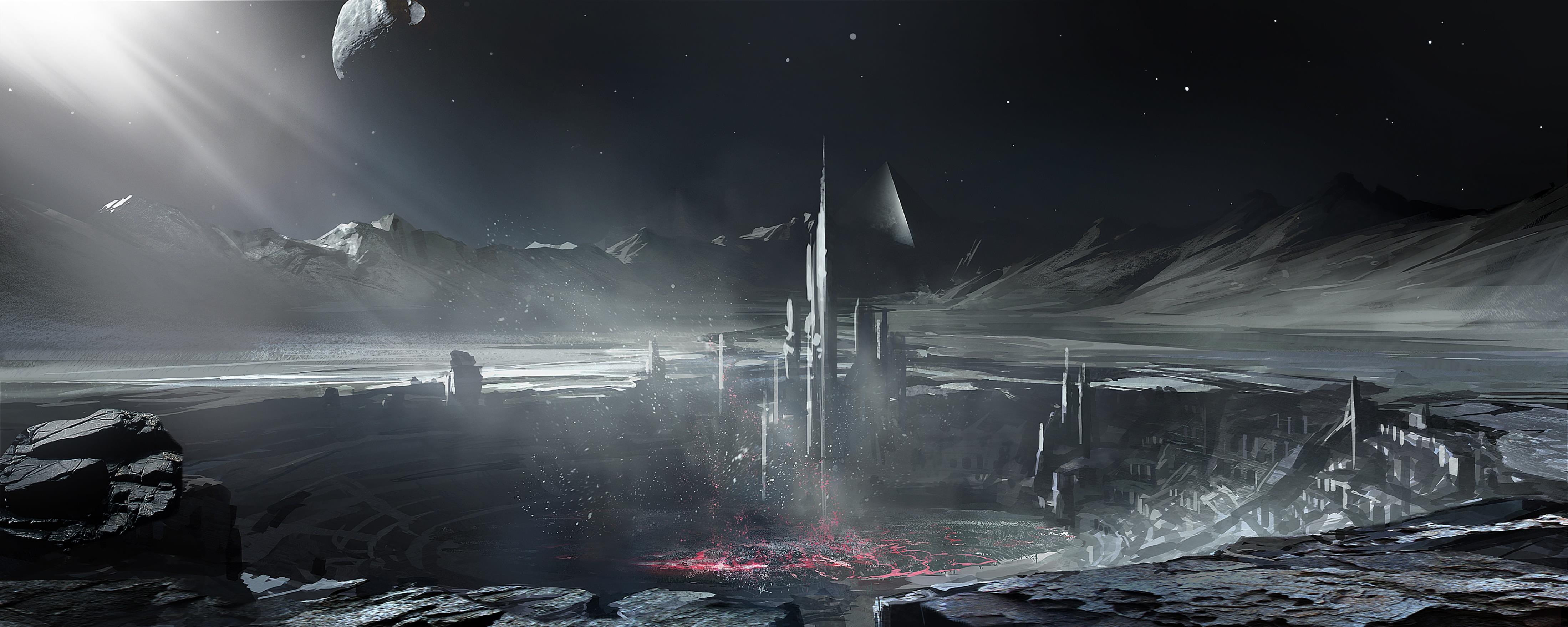
I
II
FAISAL
DR. AYMAN ALMUSHARAF III Graduation
1
ALSIYAT 437103370
Project
To those who are exhausted and in humiliation Great efforts in raising us, to those whose names we bear with pride we dedicate to you this humble work. We ask God to grant us success and reward you for our good penalty.
We extend our thanks and appreciation to the King Saud University for their efforts exerted to create a study environment that helps the students to give their energy and work, and I would like to thank Dr. Abdulrahman Abdullah AlTassan on your sincerity, hard work, education and all the following thing that Helped us to make this project possible.
IV
Justifications and motivations for colonizing Mars include curiosity, the potential for humans to provide more in-depth observational research than uncrewed rovers, an economic interest in its resources,
The Mars Colony is going to be located in Eberswalde: A Delta Within a Delta. It will have a HABITAT, RESEARCH Center, Labs, Agriculture For Food + Supplies Oxygen Generator “MAXEN”
V
Overview of the project, Emergence of the need for the project, Feasibility
Study, Objectives of the project,
02.
Space Programme
03. Site Analysis and influencing contexts
SITE LOCATION , Terrain Topographic & NAMES ,
Radiation& Atmosphere , Influencing Contexts
Crucial issues
INTRODUCTION
,Crucial issues
04. Project organization And activities’ Requirements
COMPONENTS, RELATIONS, Functional
Relationships PRIVACY LEVELS NOISE
06.
Project Design
Exterior Design considerations , Interior
Design considerations
07.
Summary and Conclusions
Design Orientation Alternatives, REFERENCE , APPENDICES
VI
General Background 01.
ANALYSIS
Space Programme 05.
Overview of the project, Emergence of the need for the project, Feasibility Study, Objectives of the project, The main functions of the project, Project Size, Project service scope, users, Outlook for the project, project site.

01.
Earth is similar to its "sister planet" Venus in bulk composition, size and surface gravity, but Mars's similarities to Earth are more compelling when considering colonization. The Martian day (or sol) is very close in duration to Earth's. A solar day on Mars is 24 hours, 39 minutes and 35.244 seconds. Mars has a surface area that is 28.4% of Earth's, only slightly less than the amount of dry land on Earth (which is 29.2% of Earth's surface). Mars has half the radius of Earth and only one-tenth the mass. This means that it has a smaller volume (~15%) and lower average density than Earth. Mars has an axial tilt of 25.19°, similar to Earth's 23.44°. As a result, Mars has seasons much like Earth, though they last nearly twice as long because the Martian year is about 1.88 Earth years. The Martian North Pole currently points at Cygnus, not Ursa Minor like Earth's. Recent observations by NASA's Mars Reconnaissance Orbiter, ESA's Mars Express and NASA's Phoenix Lander confirm the presence of water ice on Mars.

9
To design the first habitat on Mars, the main consideration will be – who will use it? In other words, who will go to Mars? Both NASA and some other private organizations (like, Space-X and Mars One) are planning to send Manned mission to Mars and their target year is around 2030. However, there is a basic difference in their strategies. NASA is planning to send a small group of astronauts cum scientists, who will land on Mars, stay for a while and come back. On the other hand, these private organizations are planning to send some selected and trained common people to stay there forever. Eventually the habitat design for these two groups will be quite different from each other. Personally, I believe, we need to wait to send a one way manned mission to Mars until a successful return mission is completed as planned by NASA. Therefore, in this paper, I will discuss about the habitat, which will be suitable for staying on Mars for a limited period of time and after that can be reused as a base for the next permanent habitat.

10
Since the 20th century, there have been several proposed human missions to Mars both by government agencies and private companies.
Most of the human mission concepts as currently conceived by national governmental space programs would not be direct precursors to colonization. Programs such as those being tentatively planned by NASA, Roscosmos, and ESA are intended solely as exploration missions, with the establishment of a permanent base possible but not yet the main goal.
Colonization requires the establishment of permanent habitats that have the potential for self-expansion and self-sustenance. Two early proposals for building habitats on Mars are the Mars Direct and the Semi-Direct concepts, advocated by Robert Zubrin, an advocate of the colonization of Mars.
SpaceX has proposed the development of Mars transportation infrastructure in order to facilitate the eventual colonization of Mars. The mission architecture includesfully reusable launch vehicles, human-rated spacecraft, on-orbit propellant tankers, rapidturnaround launch/landing mounts, and local production of rocket fuel on Mars via in situ resource utilization (ISRU). SpaceX's aspirational goal as of 2017 was to land their cargo Starships on Mars by 2024 and the first 2 crewed starships by 2026.

11
In terms of protection, this habitat will be the most protected one we have ever built. Here, the major considerations will be solar and cosmic radiation, extremely cold temperature (the mean surface temperature of different locations of Mars varies from -124.6° F to 23° F, while the lowest temperature ever recorded in Earth was 135.76° F in Antarctica), low atmospheric pressure. According to Stefen L. Petranek, “On Earth, we live under a very tall pile of atmosphere….. That atmosphere, on average, weighs 14.7 pounds per square inch at sea level. Our bodies push out against the constant pressure. On Mars, where the atmospheric pressure is less than one one-hundredth that of Earth, no human could live long without a pressure suit to match the outward push of the body.”) [3] [Petranek, How We‟ll Live on Mars] and an air controlled interior to keep oxygen level steady (“Martian air has a partial pressure of CO2 of 0.71 kPa, compared to 0.031 kPa on Earth. CO2 poisoning (hypercapnia) in humans begins at about 0.10 kPa. Even for plants, CO2 much above 0.15 kPa is toxic. This means Martian air is toxic to both plants and animals even at the reduced total pressure)” Obviously, it will not be an economical solution to transport all the materials from Earth to Mars.) Besides these two options, the third one can be a suitable combination of the first two options. Later in this paper, I will discuss this option with a hypothetical example of “Martian Ice House” in case study section. The good thing is before finding out the most suitable option, NASA is not going to send any human soul on Mars, which means that it needs to be ensured maximum survival possibilities beforehand. However, that cannot assure a complete successful mission. Simply because, survival is not equivalent of living. Human being has a great survival history through generation to generation. We can adopt with any extreme environment and difficult situation (Human being knows how to survive in a desert, under ocean water or freezing polar areas. we have survived thousands of war, natural disaster, famine or epidemic of lethal disease). There is no doubt that our species are quite able to make this long journey to Mars and survive in that alien environment with the help of appropriate technical support. However, the question is - how long a human crew will remain properly functional to complete a successful mission without a „Livable Habitat‟? The other name of this „Livable Habitat‟ is „Home‟. Therefore, it is time to consider this big issue .
12
Martian habitat has to be the most sustainable habitat ever built. It needs to be not only less energy consuming but also selfsufficient in energy production. The recycling system for air, water, waste and other materials has to be almost 100% efficient.
At the same time, the maintenance needs to keep as minimum as possible within the reach of the crew‟s expertise. Besides these, the most important consideration will be design every inch in best economic way.

13
MARS COLONIZATION RACE
HARVISING WATER AND MINERALS
DEVELOP NEW FORMS OF TRANSPORTATION
MARS IS THE MOST SIMILAR PLANET TO EARTH
UNDERSTANDING THE SURFACE OF MARS

3
14
2030 VISION SPACE PROGRAM

15




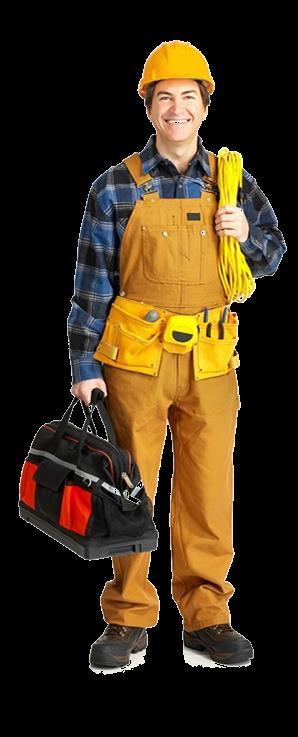









16
1.1
SITE LOCATION OPTIONS
Columbia Hills, Gusev Crater: Home to Mars Rover Spirit



Mineral springs once burbled up from the rocks of Columbia Hills. The discovery that hot springs flowed here was a major achievement of the Mars Exploration Rover, Spirit. The rover's discovery was an especially welcome surprise because Spirit had not found signs of water anywhere else in the100-mile (160-kilometer)-wide Gusev Crater. After the rover stopped working in 2010 studies of its older data records showed evidence that past floods that may have formed a shallow lake in Gusev.
Holden Crater: Shaken and Stirred

Violent impacts and fluid flows blasted and carved Holden Crater. Scientists have flagged the old impact crater as a place that could have had habitable conditions for microbial life. Minerals here formed in a body of water the size of Lake Huron. Water flowing out of the broken crater rim swept away layers of sediment and revealed even older clay sediments from another, earlier lakebed. That older lake could have existed for thousands of years, long enough for microbial life to take hold. The clays have the potential to preserve signs of life.
Eberswalde: A Delta Within a Delta
A big body of water left behind dried lake-bottom deposits in this crater.Scientists still favor this location because it contains an ancient delta at the foot of a Martian river. Deltas only form in places where water existed over long periods of time. A wellpreserved network of water-flow features exists here, including winding stream channels and riverbeds. Reactions between water and volcanic rock created the clays found here. Clay minerals are an important sign of a watery past. They also have the potential to preserve any signs of life for a long time.
Jezero Crater: Wet and Dry and Wet Again
Jezero Crater tells a story of the on-again, off-again nature of the wet past of Mars. Water filled and drained away from the crater on at least two occasions. More than 3.5 billion years ago, river channels spilled over the crater wall and created a lake. Scientists see evidence that water carried clay minerals from the surrounding area into the crater after the lake dried up. Conceivably, microbial life could have lived in Jezero during one or more of these wet times. If so, signs of their remains might be found in lakebed sediments.
1 2 3 4
18
SW Melas: Part of the Largest Canyon in the Solar System
What lies in the layers of the lakebed and shores of ancient SW Melas? A lake or delta once sat in this basin. Its water interacted with the wide variety of minerals that exist in the surface. There are layers of volcanic ash interspersed with clays. The clays, formed from eroded rock particles were laid down by water. This formerly watery, volcanic environment may preserve signs of past microbial life. 6
Nili Fossae: A Splashy Array of Minerals and a Dash of Methane


Big forces of nature shaped Nili Fossae. Impacts hammered its surface. Shifting tectonic faults caused great blocks of the surface to drop and form valleys. The water altered chemicals and minerals in the rocks here, producing clays and rocks with large amounts of silica. Methane can come from natural geologic processes (e.g., volcanics) or from living organisms. Scientists would like to know the source of that methane.
NE Syrtis: Once Warm, and Wet
Volcanic activity once warmed NE Syrtis. Underground heat sources made hot springs flow and surface ice melt. Microbes could have flourished here in liquid water that was in contact with minerals. The layered terrain of NE Syrtis holds a rich record of the interactions that occurred between water and minerals over successive periods of early Mars history.
7 8
Mawrth Vallis: A Mysterious Water Source

Orbiting spacecraft take pictures that show the sources of Martian river channels. The pictures give scientists a good idea of how water once filled ancient lakes. A mysterious channel emerges out of nowhere. The channel is not linked to runoff from higher areas. Scientists think that the water that created the channel seeped from beneath the surface. Regardless of the water's source, the channel excavated the clay deposits.

5
19
PROJECT SIZE:
Project Size: Estimated Build Area 6600m2
Number Of Estimated Staff 110 People
Number Of Estimated Visitors 900 People
PROJECT SERVICE SCOPE:
Geographical scope: Researchers and scantest in Saudi Arabia
Social Scope: Medal East and worldwide tourists
FUTURE OUTLOOK OF THE PROJECT:
1. The Project is in Line with the Economic Orientation of the Kingdom
2. It Will be the Channel of Scientists, Researchers and Tourists Interested in Space
This map shows the top of Jezero Crater’s delta. The rover’s planned route is in black, with black dots representing notional waypoints for science or sampling along the way, while the ground it already covered is in white.

20
Map of Eberswalde: A Delta Within a Delta
1.2
PROJECT BUILDING TYPE
The Project Contains fore Buildings the Administration Building , Agriculture , Educational & RESEARCH , Information & Resources Center and Utilities Oxygen Generator “MAXEN” , Energy Storage Furthermore Staff & TOURIST Residency And Public Facilities for outdoor activities .

22
MYCELIAL MAT
Mycelium (plural mycelia) is a root-like structure of a fungus consisting of a mass of branching, threadlike hyphae. Fungal colonies composed of mycelium are found in and on soil and many other substrates. A typical single spore germinates into a monokaryotic mycelium
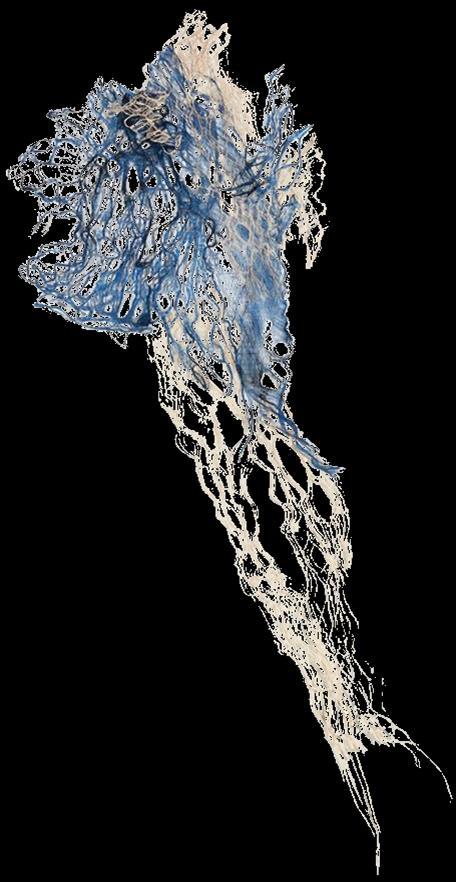
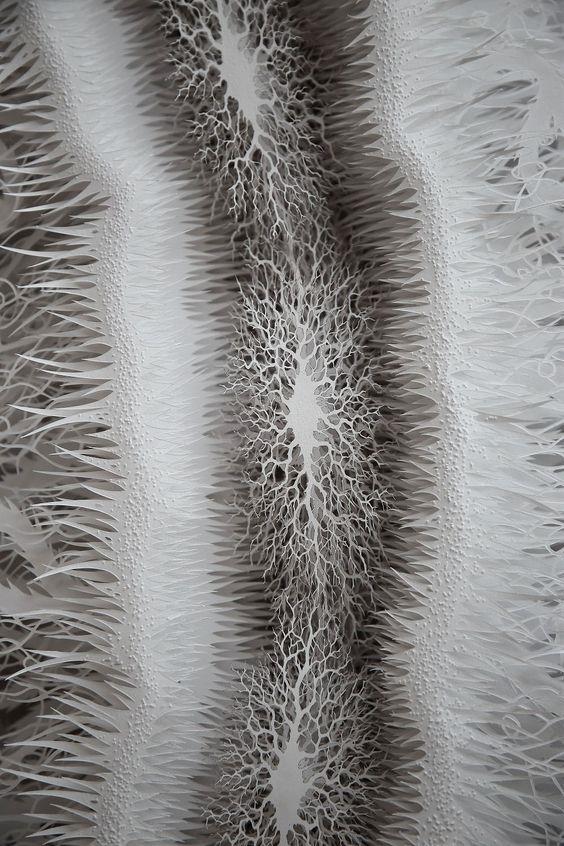
One of the primary roles of fungi in an ecosystem is to decompose organic compounds. Petroleum products and some pesticides (typical soil contaminants) are organic molecules (i.e., they are built on a carbon structure), and thereby show a potential carbon source for fungi. Hence, fungi have the potential to eradicate such pollutants from their environment unless the chemicals prove toxic to the fungus. This biological degradation is a process known as bioremediation.
Mycelial mats have been suggested as having potential as biological filters, removing chemicals and microorganisms from soil and water. The use of fungal mycelium to accomplish this has been termed mycofiltration.

23
1.3
For this study, Amit Bandyopadhyay, along with graduate students Ali Afrouzian and Kellen Traxel, used a powder-based 3D printer to mix the Martian rock dust with titanium. A high-powered laser heated the materials to over 2,000°C (~3600°F). Then, the molten mixture was cast on a moving platform that allowed the researchers to make parts of different sizes and shapes. Once the material cooled down, tests were conducted to explore its strength and durability. This innovation could make it possible to manufacture parts directly on Mars. Amit Bandyopadhyay says, “In space, 3D printing is something that has to happen if we want to think of a manned mission because we really cannot carry everything from here, and if we forgot something, we cannot come back to get it.”
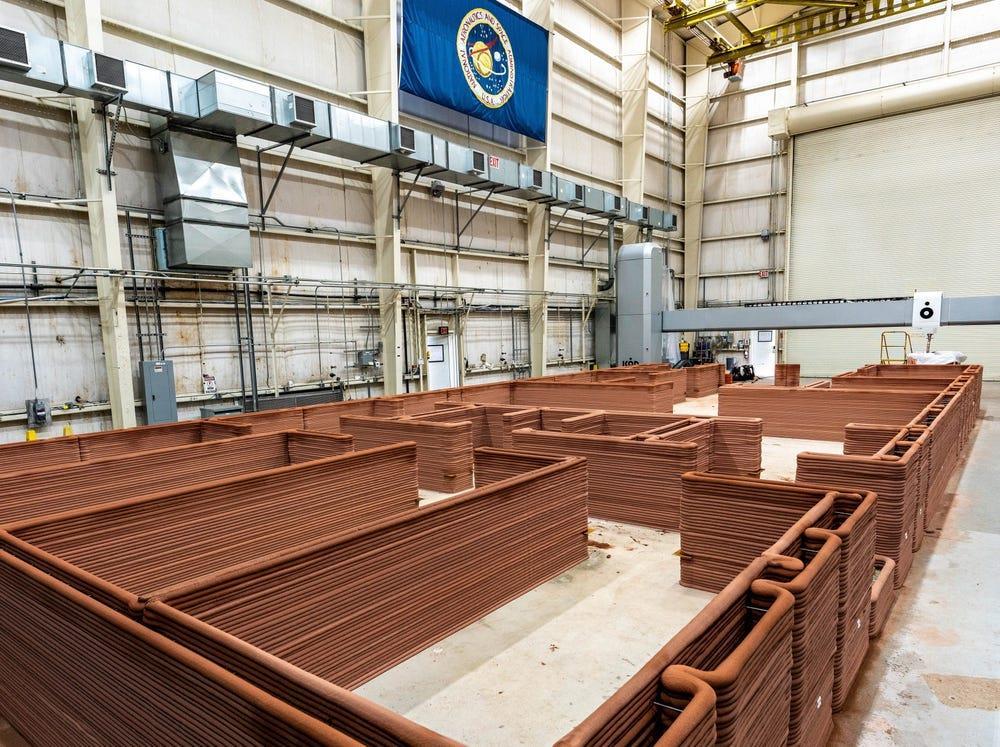
25
ASTRA is a full-stack robotic 3D printer engineered for scale and simplicity. We combined industrial robotic performance with state of the art extrusion and material handling technology, recycled 3D print material, and automated code generation. With ASTRA, you’re accessing NASA award-winning technology to build beyond conventional boundaries of material and dimension.
The ABBIRB-6700is a six axis robotic armthat canhandle up to a245 kg payloadand has a 3m reach. Six degrees of motion and extensive reach allow forboth anorthogonal and polarbuild envelope.
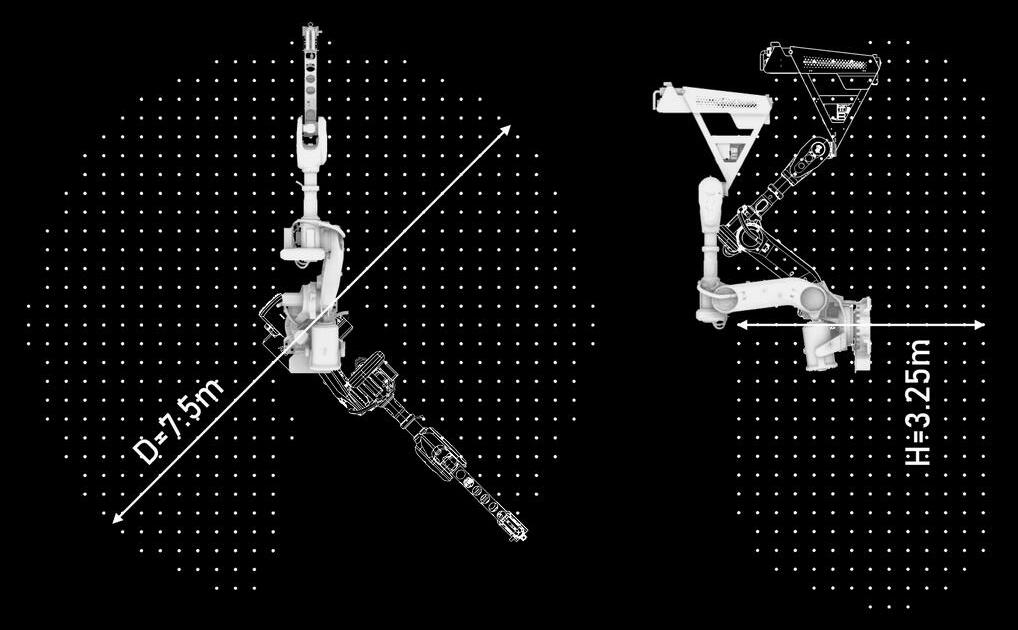
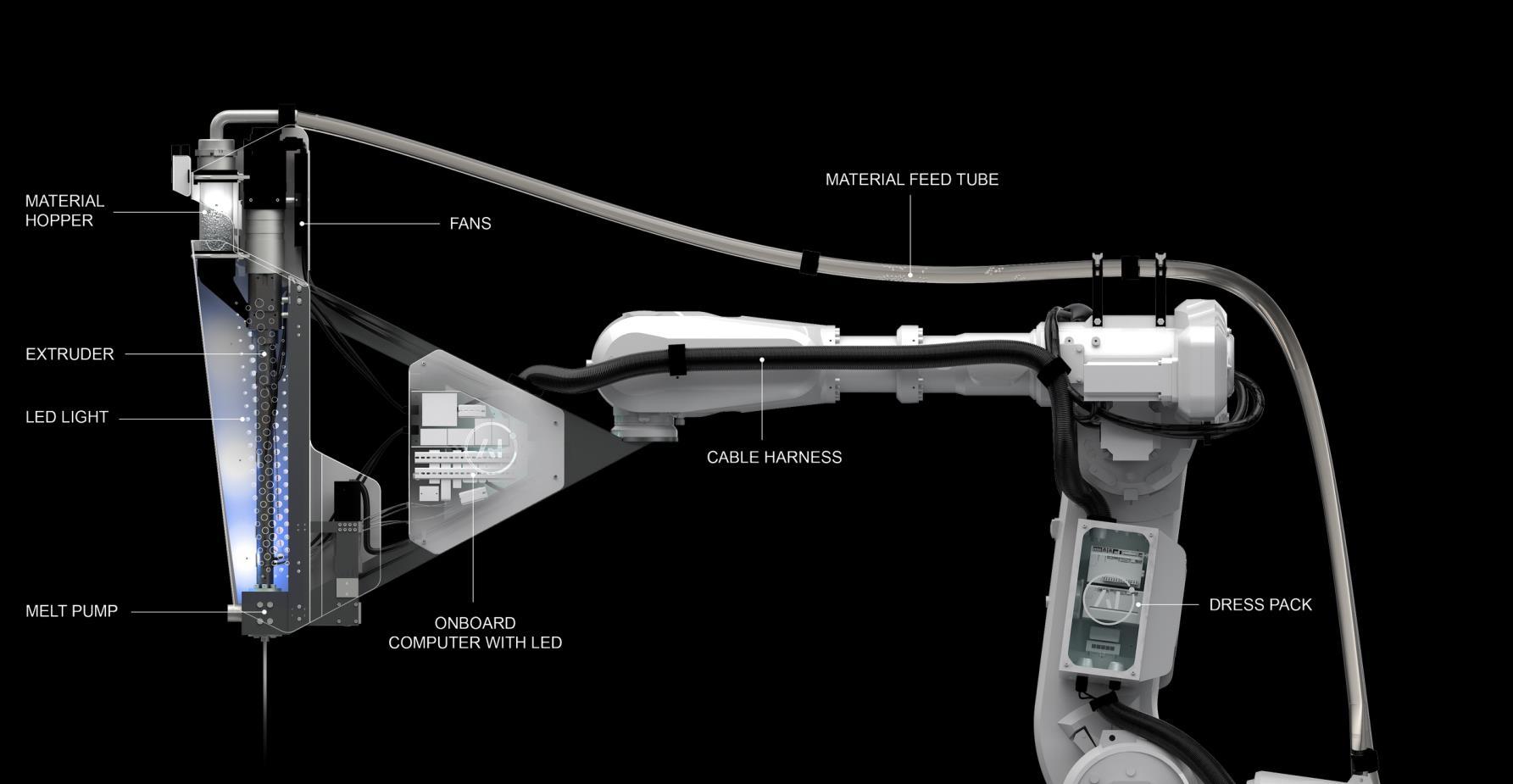

Robot:X: 2560mm Y:1009 mm
Z: 2321 mm
RobotMass: 1540 kg
TCPOffset: X: 1152 mm Y: 0 mm
Z: 605mm
End EffectorMass: 132 kg
Barrel Length: 762 mm
Barrel Inner Diameter: 30 mm
Nozzle Diameter: 12 mm
26
Our proprietary 3D print materials are 100% post-industrial plastics reinforced with glass fibers. We’ve used this high-strength composite to produce structures which span and support heavy loads. Every 3D printed scrap of material can be recycled and reprinted so that absolutely nothing goes to waste.

The material flow is controlled by a 22 liter, 700AW vacuum. System noise is minimized through an integrated muffler near the motor. The vacuum filter is easily serviced by opening the station doors and dropping the housing onto the lower rest.
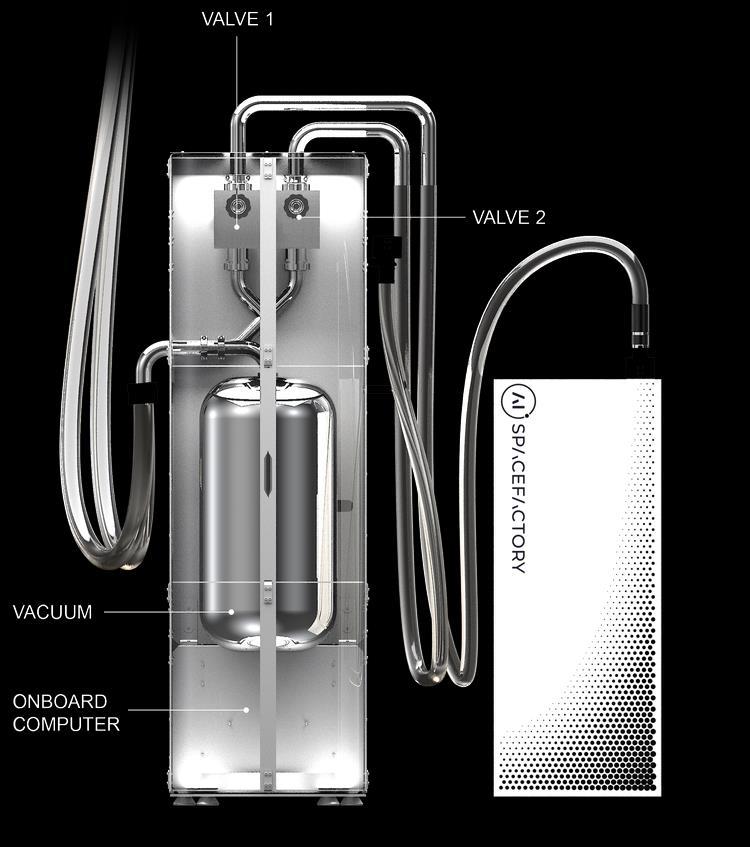
27
1.4

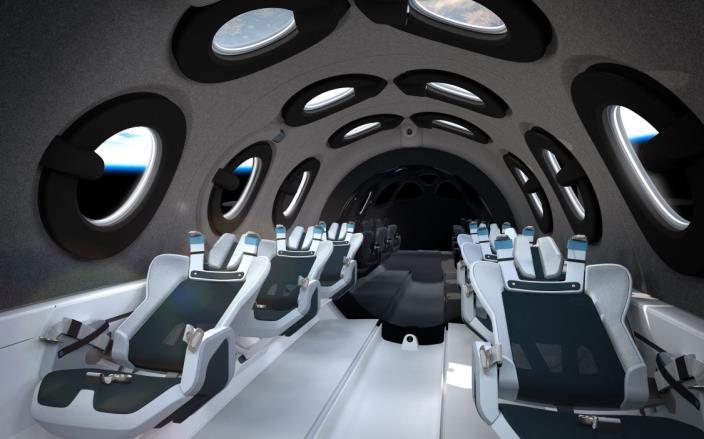
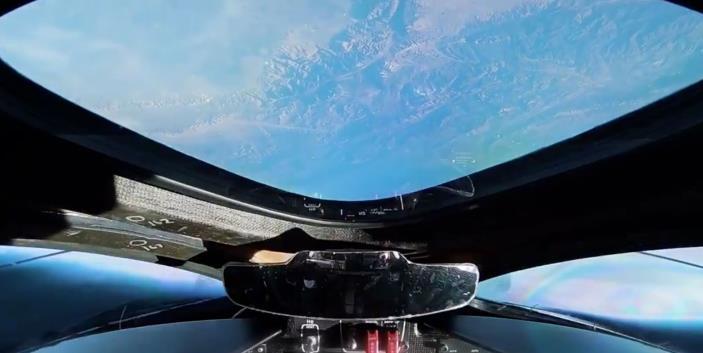

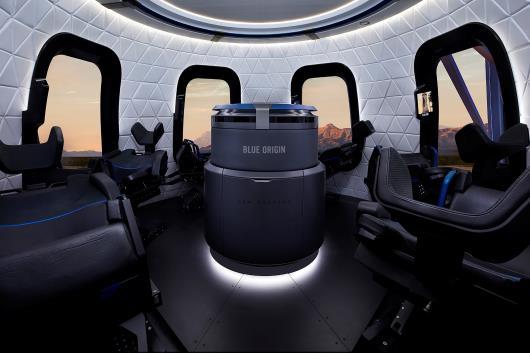



29



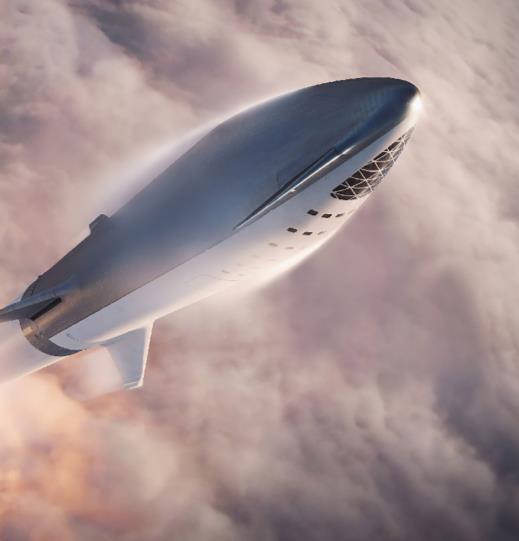
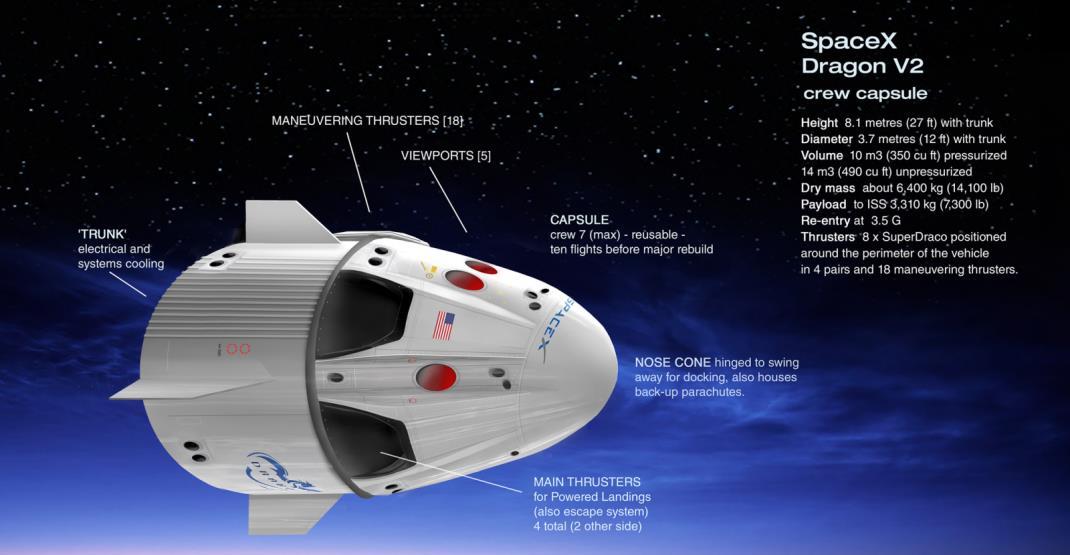
30
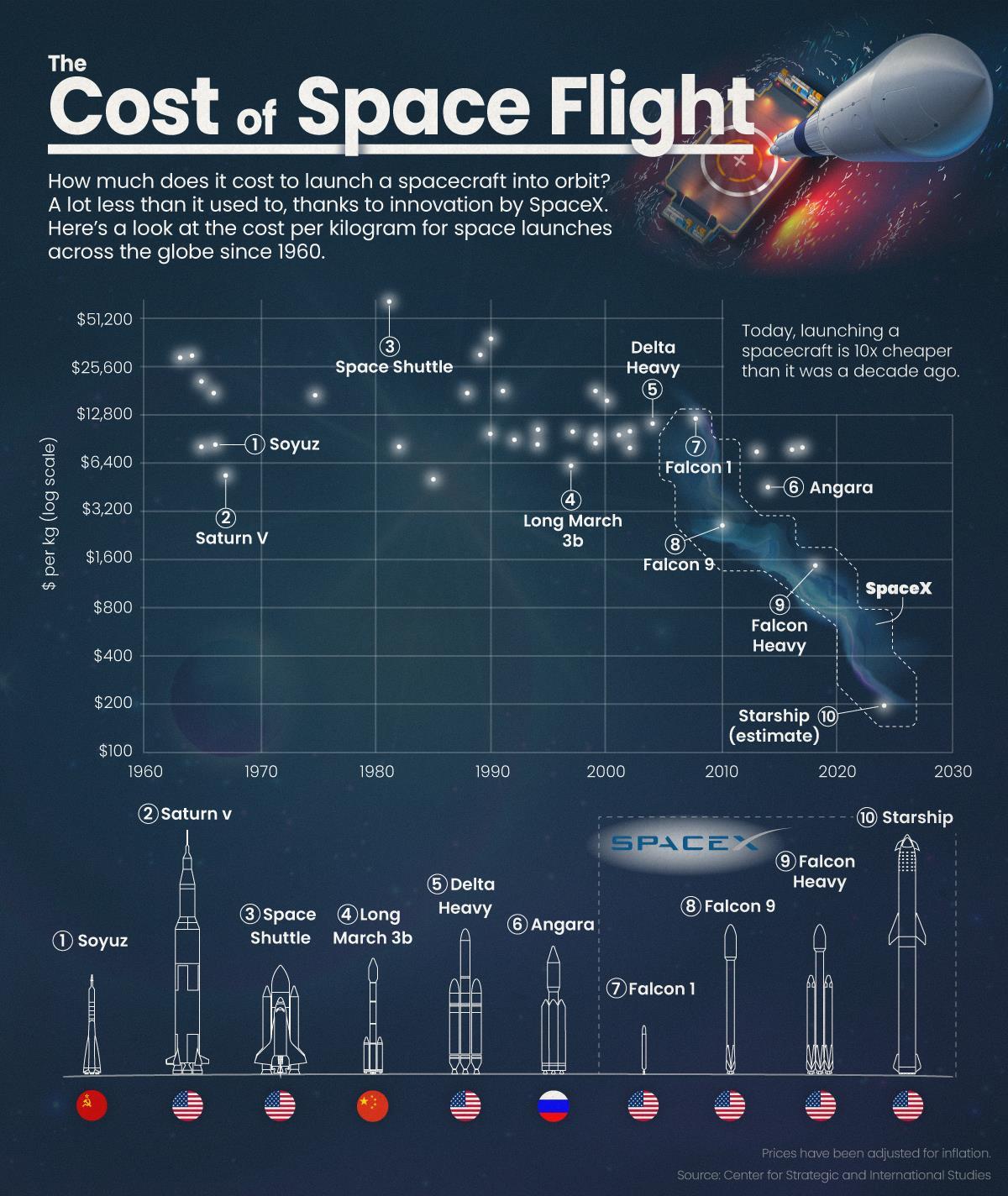
31
1.5

33

34
1.6
Solar Energy

The location of the settlement – Mawrth Vallis (23.9883°N, 341.0399°E) – is chosen to be in an area of maximum solar incidence. Therefore, the amount of solar power, that can be gained, will get the astronauts far. In times of good insolation, the panels will probably produce redundant energy, which will be saved by batteries for times where little sunlight is available.
Nuclear Power
During global dust storms, the energy gain of solar panels will be diminished. Thus, a reliable backup, that can produce energy-amounts large enough to provide for the settlement, will be necessary. Also, energy needs of the colonies’ in-situ production (construction elements, food etc.) need to be considered.
A Liquid Fluoride Thorium Reactor is a nuclear reactor that is much safer (no risk of nuclear meltdown, low pressure, leak resistance, dramatically reduced radioactivity of nuclear waste, can use existing nuclear waste as fuel)

36
Water generation
To mine water on Mars, it would not be necessary to excavate frozen material and bake it.
Microwave beams could be used to vaporize the water ice so it could be collected. This process would only require small-scale drilling and little digging12
The Sabatier Process
oxygen and water for fuel and life support on-site could be used to minimize launch mass and therefore costs of a Mars mission. The reaction involves carbon dioxide (CO2) from the Martian atmosphere and hydrogen (H2), either delivered from Earth or Moon or produced on the Martian poles. CO2 + 4 H2 → CH4 + 2 H2O → CH4 + O2 + 2 H2
Oxygen Production


. According to Allen and Zubrin, a small Sabatier reactor with the volume of 1 liter will produce sufficient .

37
1.7
SIMILAR PROJECTS
MYCOMARS

2021 40
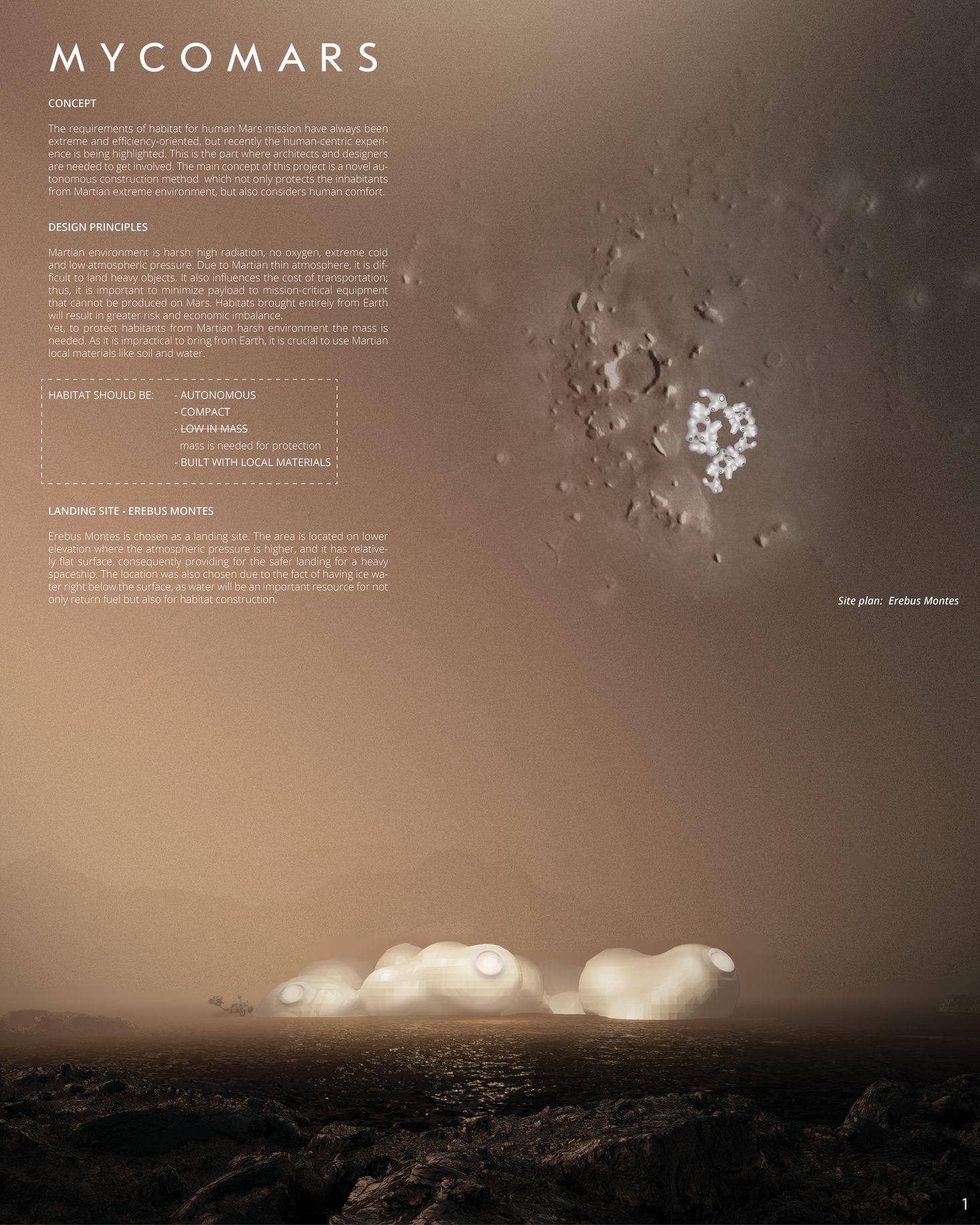
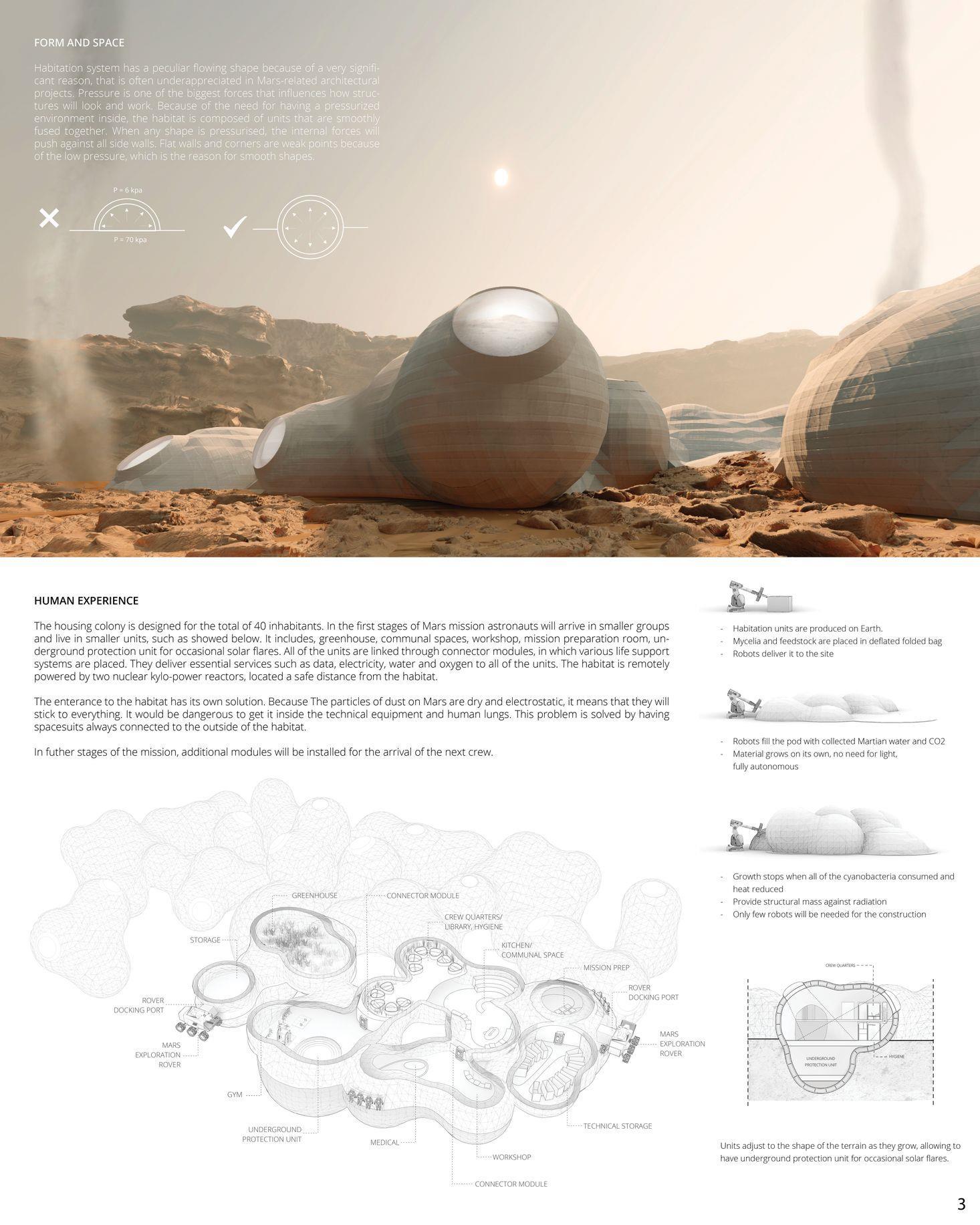
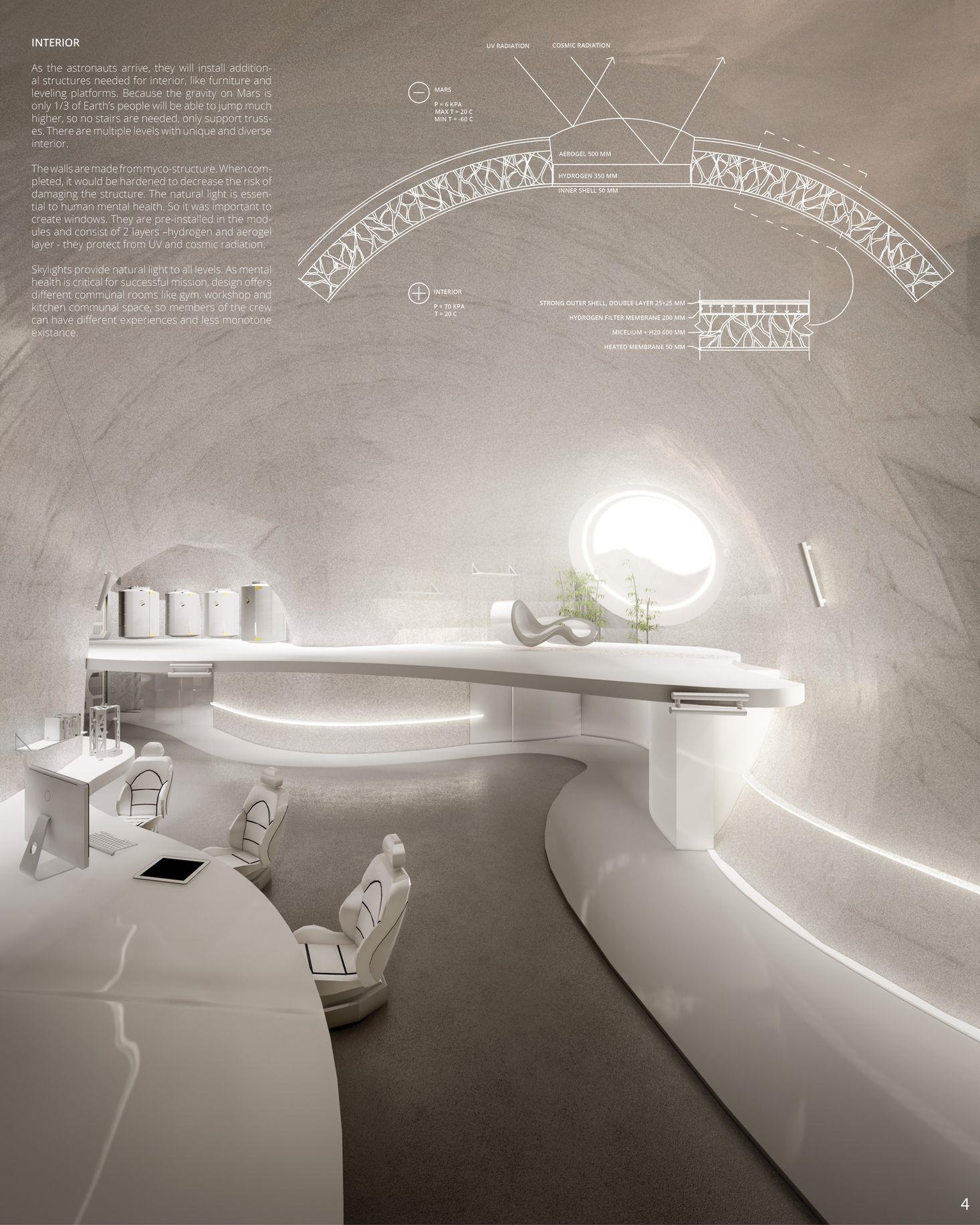
41
MYCOMARS is an autonomous habitation unit which
not only protects the inhabitants from Martian extreme environment, but also considers human comfort. A mycelial-based construction provides the right conditions: protects from radiation, thermal flux and dust, while still allowing natural light to flow through and requires significantly less energy to produce.


42
ILO

2021 43
LenzArchitects:Wearepleasedtopresent toyoutheresultofalongarchitecturaland scientificworkfromLenz-productionand researchstationILO(IdentifiedLevitating Object).Ourarchitecturalcompany organizedawholescientificgroupof physicistsandengineers.Theobjectisa staticbaseandalevitatingproduction stationthatmoveswithself-generated energy.Wedidnotjustcreatean architecturalconcept.Usingascientific approachandmakingascientific conclusion,wecalculatedamagnetic levitationonMars.

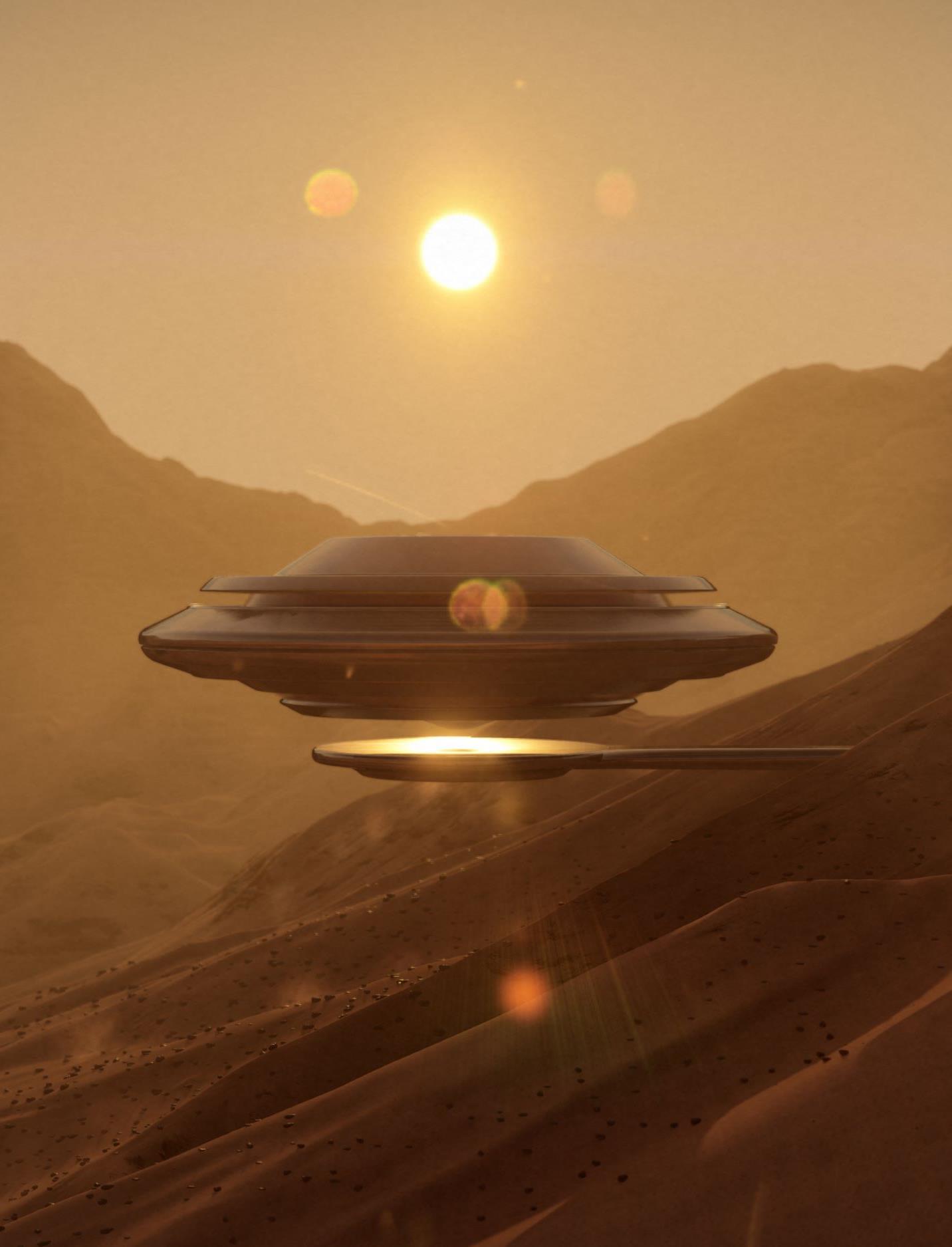

44
Themaingoaloftheprojectis,ofcourse,the solutionofglobalproblemsoftheEarth,suchasair pollution,climatedegradationandoverpopulation. Itisstill veryearlytotalkaboutaqualityhumanlife onMars,becausethisrequiresatleasthundredsof yearsofartificial terraformingoftheplanet. ILOstation, usinglocalmaterials,canproducethe necessarymodulesandtransportthemtoother bases.Bycollecting solarenergy,thestationcan conductlong-term explorationoftheplanet.

Constantmagneticlevitation allowsyounotto wasteenergyontakeoffandovercomedifficult landscapeobstacles.
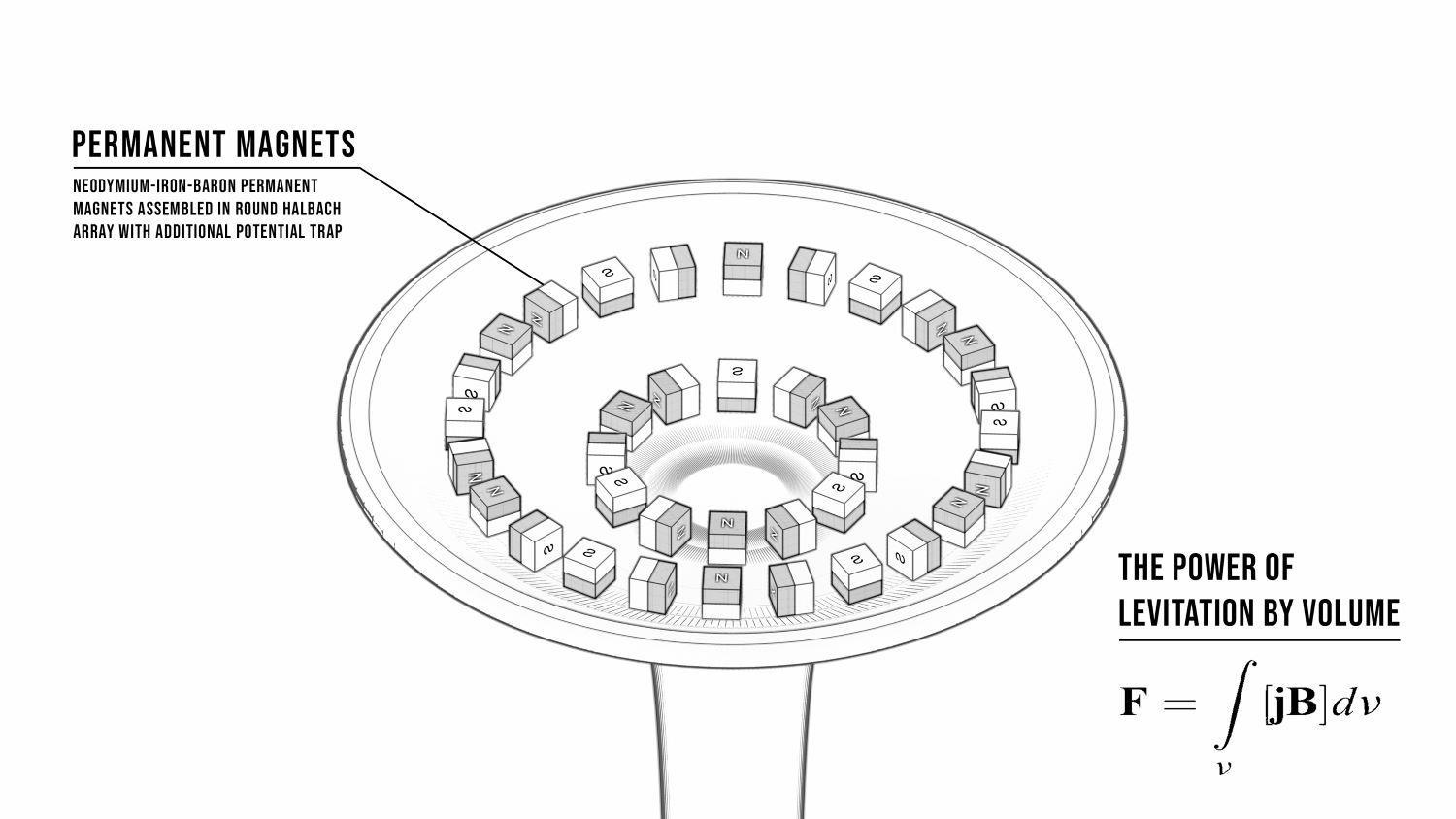


45
THE COLONY

2021 46
Theconceptassumesthatthe vastmajorityofedibleswillbe producedonsite.Offerings rangefromvariousmixesof hydroponic/ aquaponic/aeroponicfarming, insectbreeding,smallanimal breeding,andbreedingviable smallfishspecies,Energy sourcesarebasedontheuse ofnuclearenergy,backedupby variousadditionalenergy sourcessuchassolar,wind, possiblygeothermal,etc.

47
Thevillageswillbebuiltsimultaneously around theedgeofthecrater.Theywillallow residents tointeractthrough an interconnected networkoftunnels, Plentyof powerandheavyequipment willallow residents totakeadvantage ofMars'natural geomorphology andtunnel inside thecrater rimtocreateavasthabitablespacethatis easilypressurizedand protectedfrom radiation.

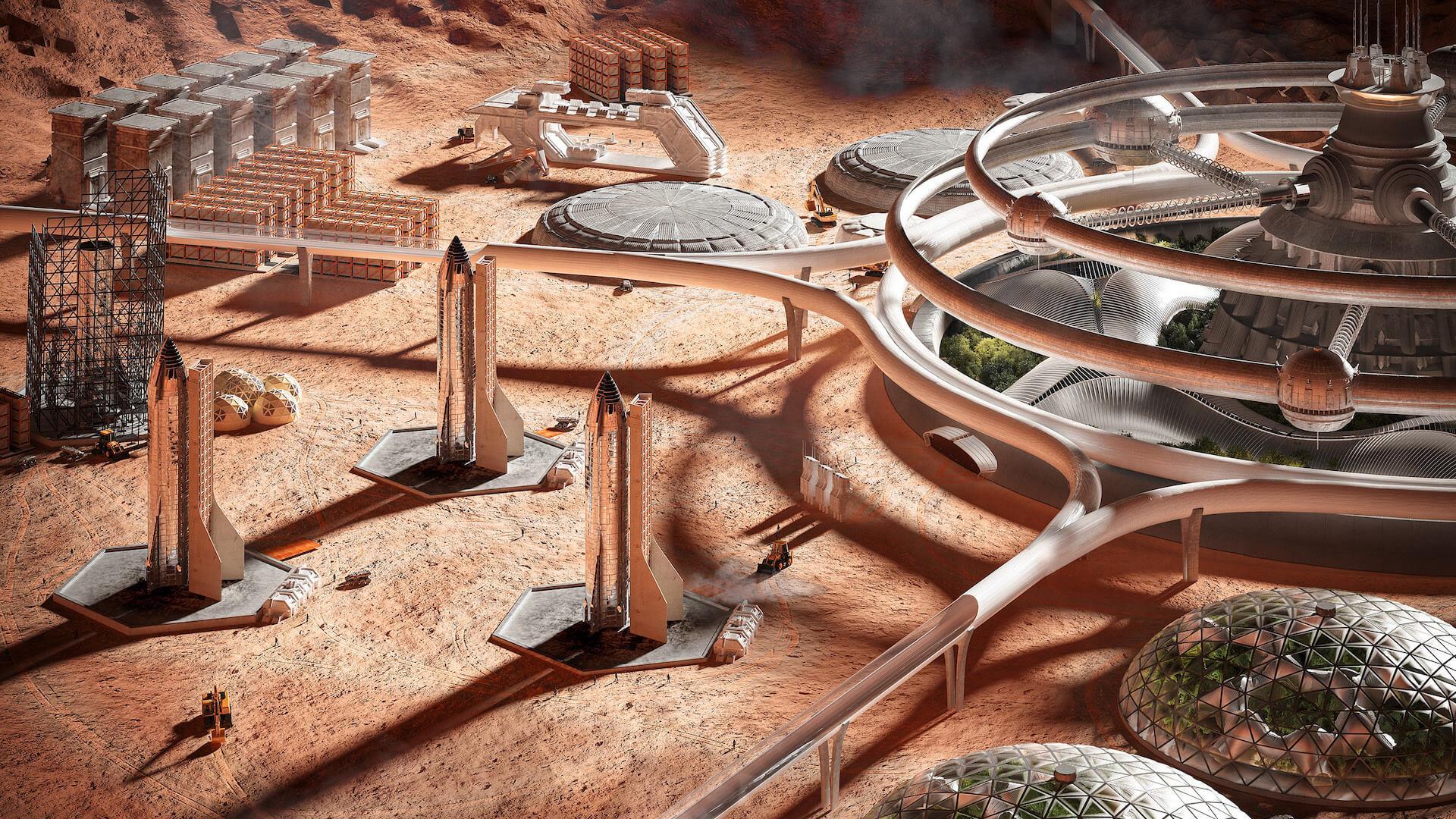

48
PARVUS SYRTIS

2020
49


50

51
LAB’S BIOPOD

2021 52
The BioPod follows the modular principle in design, durable and easily deployable. It combines advanced crop cultivation technology with predictive monitoring to achieve high-precision agriculture. It is built out of high-performance materials which are resistant under extreme climate conditions. Its integrated, advanced atmospheric and full closure water system allows the creation of specific environmental conditions that can grow a diverse array of crops and plants that would not survive in traditional indoor farming models.


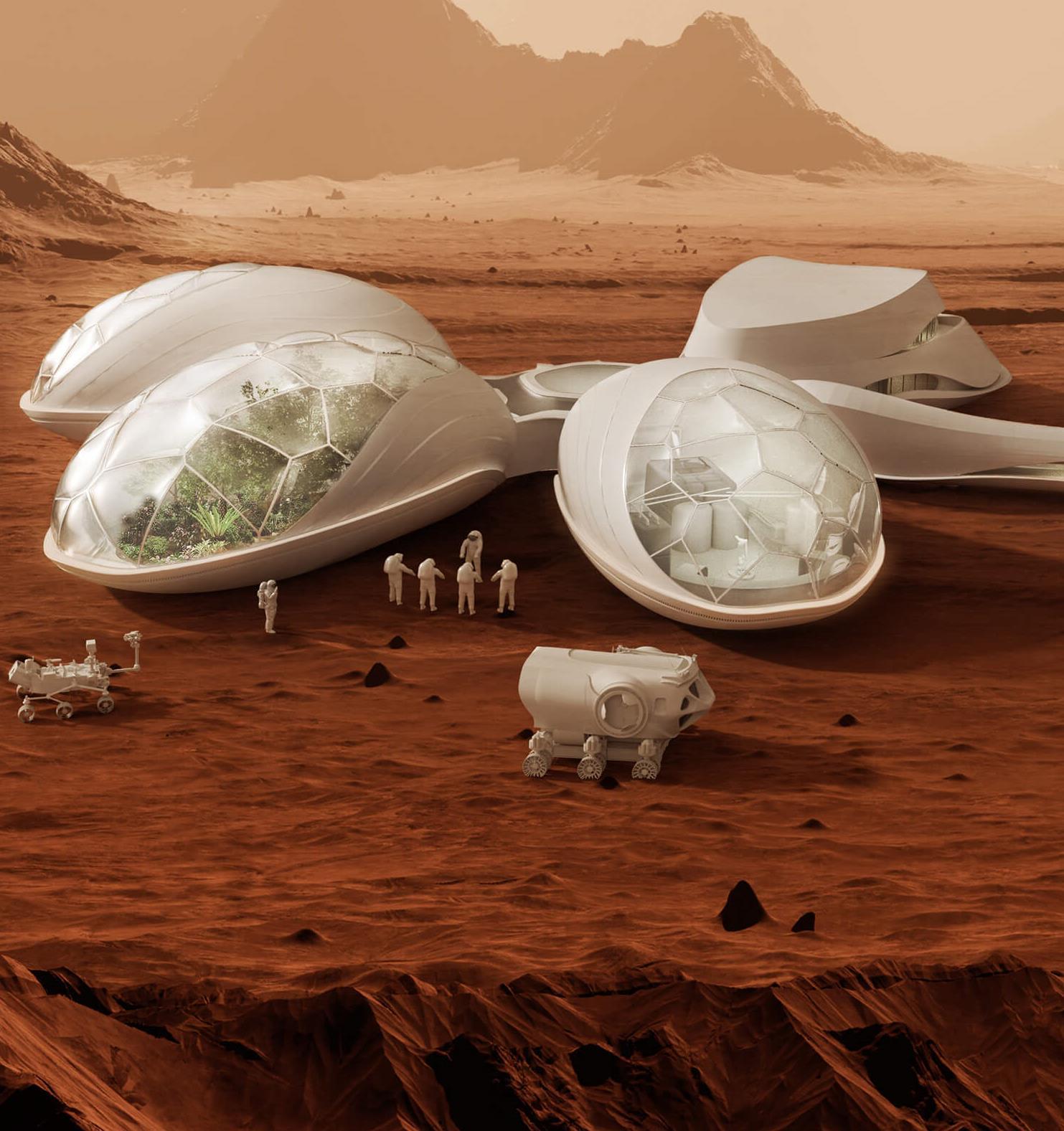
53



54

55
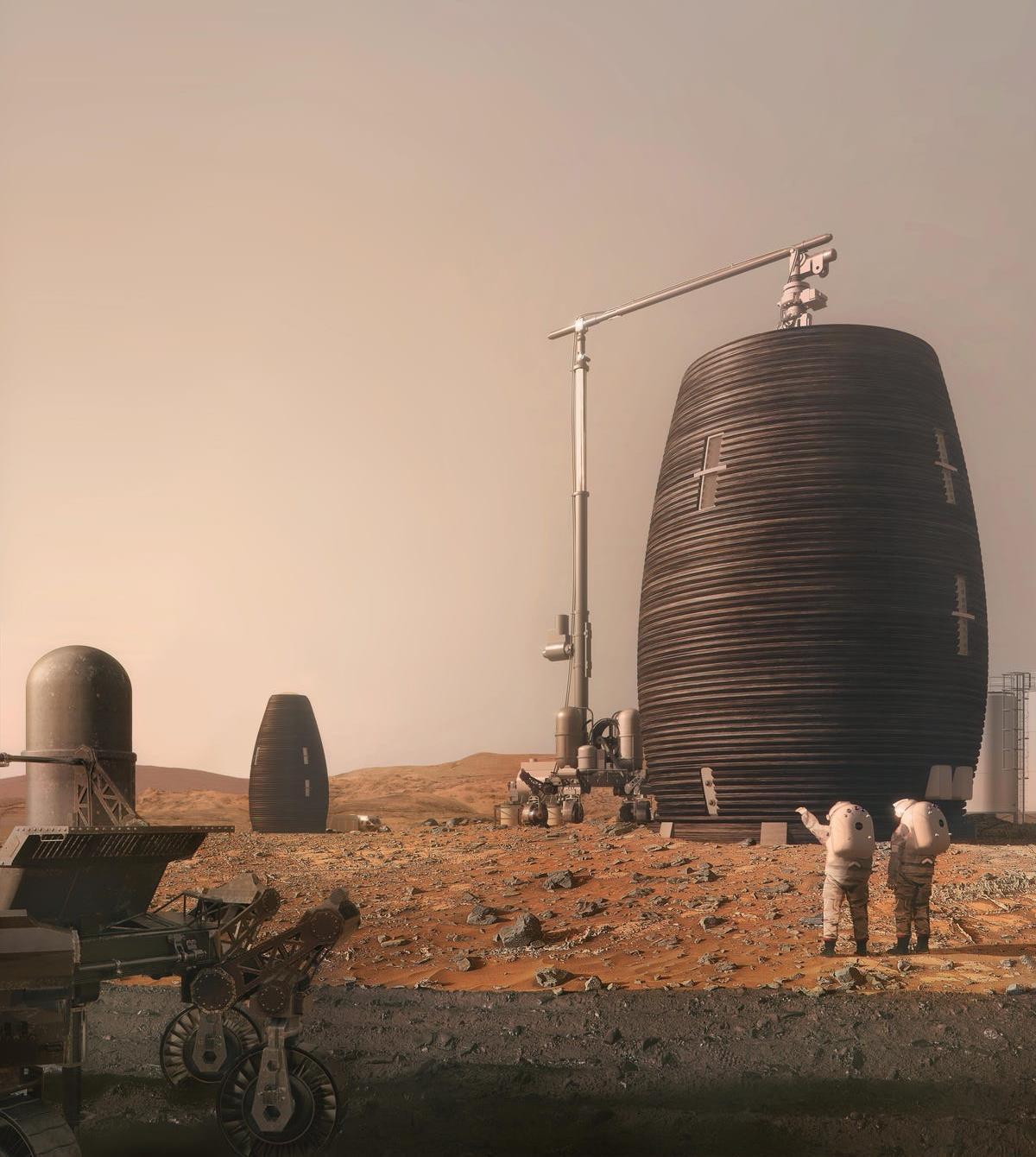

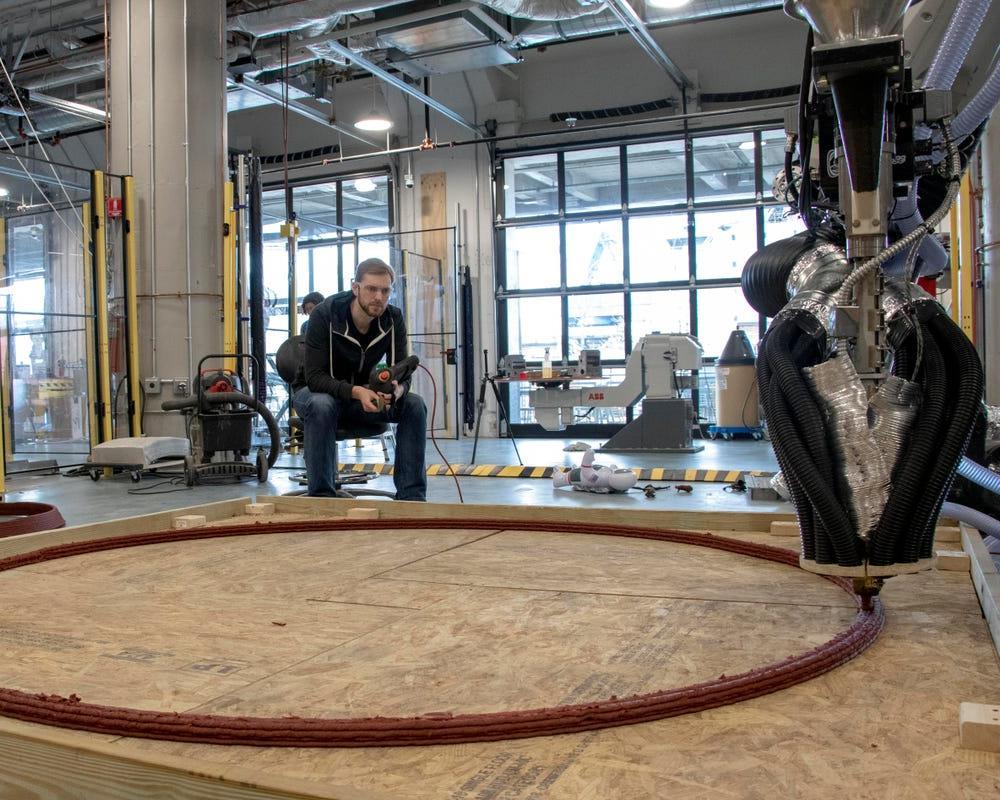
56

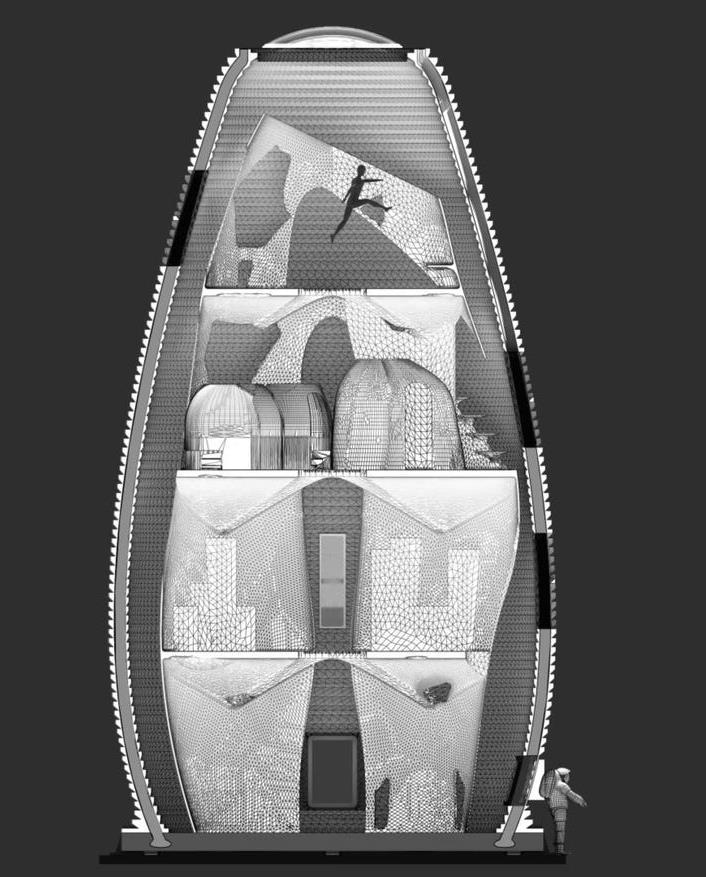
57


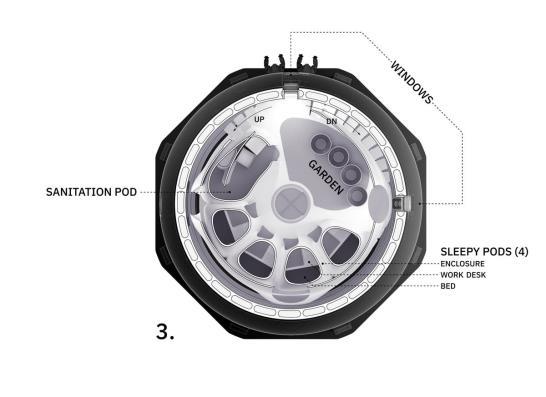
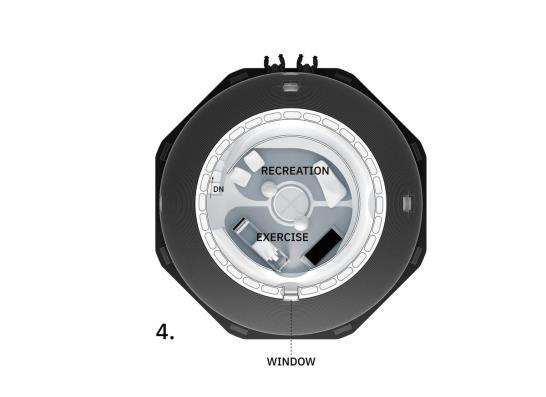

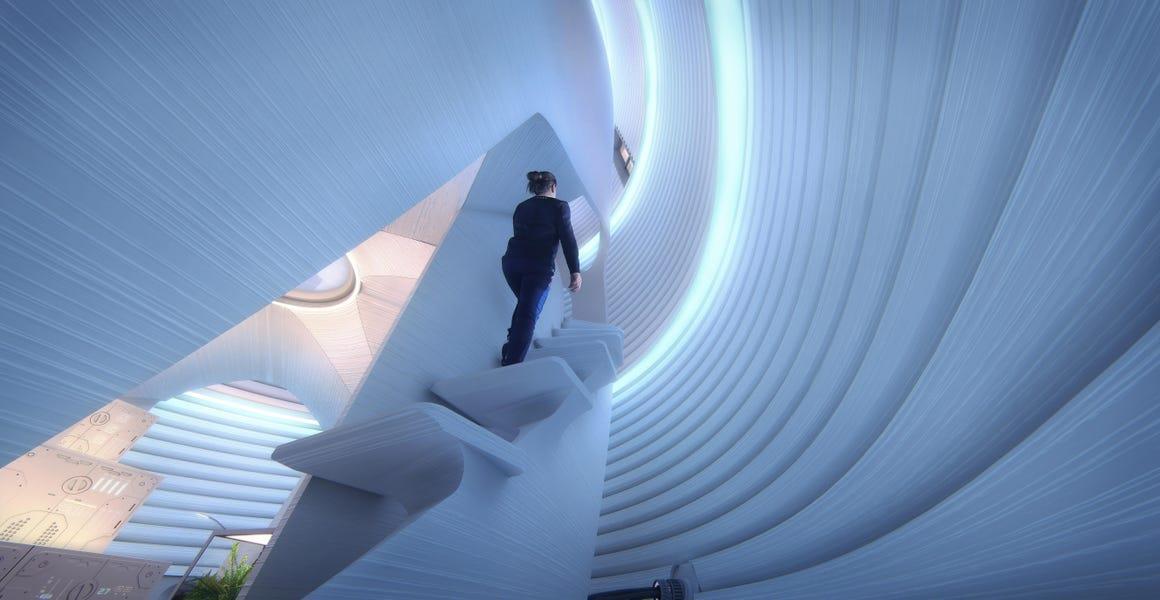
58
Components of the project, Relations, Security and safety
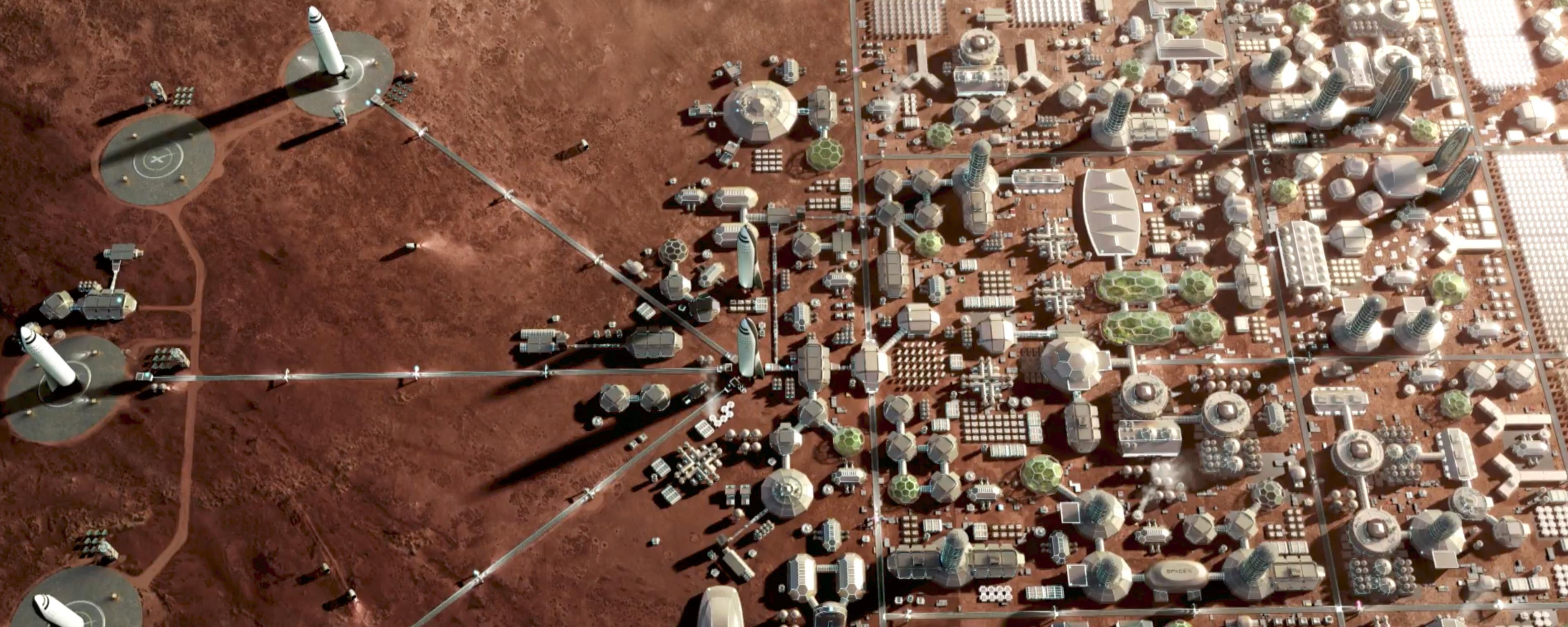
02.

60
2.1
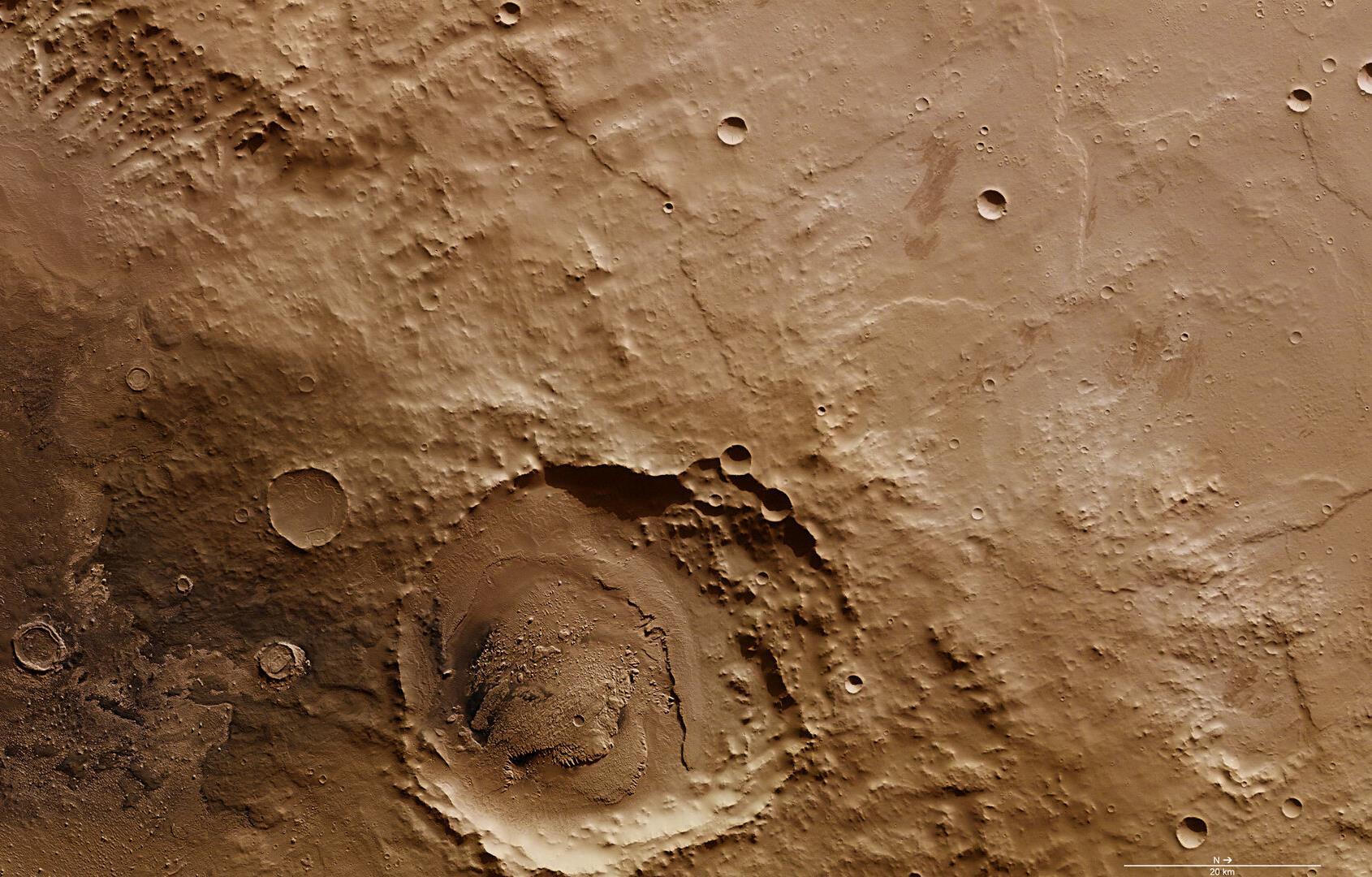


62
2.2


64
2.3
Remnants of valley networks across the scene indicate that water once flowed through this region, shaping the features seen today. Indeed, as shown by the context image, Parana Valles lies to the east, while Loire Valles lies to the northwest.





‘Chaotic terrain’ is visible both inside and outside the crater, marked by randomly oriented blocks separated by troughs. In general, chaotic terrain is associated with the collapse of the surface above regions where large amounts of subsurface water have been released.


66
2.4 67
68
▪ PLENTY OF CARBON
▪ SIMILAR TO EARTH
▪ Thin Atmosphere
▪ NO BREATHABLE AIR
▪ ICE Underground Water
▪ MINERALS Caves
▪ High Levels of Radiation
▪ LOW PRESSURE
T O W S
69
03.
Type of buildings to which the project belongs, Architectural Trend, Study of contexts, Critical issues, Study and analyze similar projects
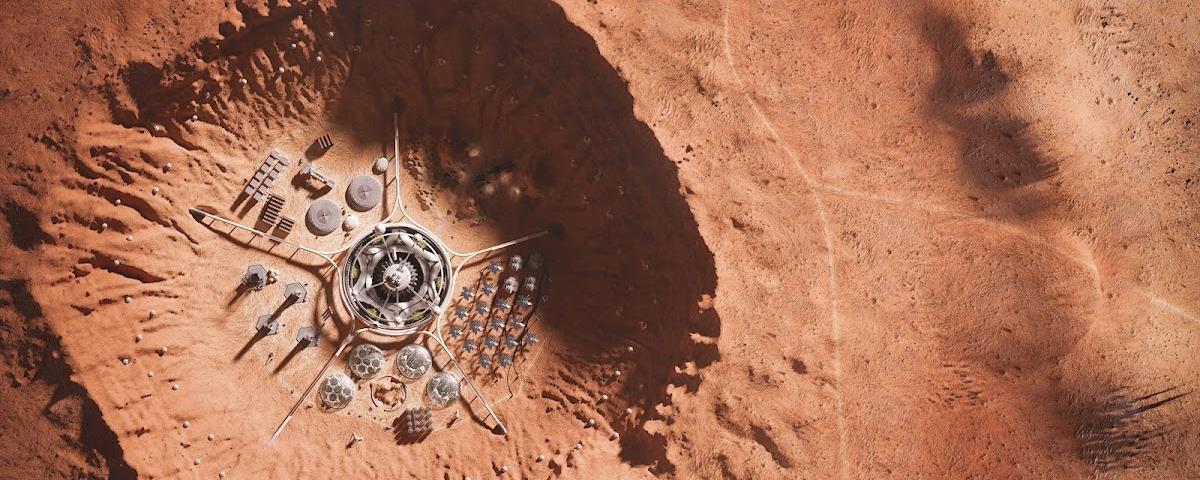
In the third phase, the most critical issues affecting
The project, how to identify and analyze it, and possible responses to deal with it
With these issues and justifications for identifying them and knowledge sources
Showing similar examples help in solving issues in a better way and development
The concept, challenges and conclusion
71
CRITICAL ISSUES
Thin Atmosphere
One of the most important attributes a planet needs to support human life is an atmosphere. Unfortunately, a very thin one clings to Mars .
Is mostly composed of carbon dioxide (95.3% compared to less than 1% on Earth).
Has barely any oxygen (0.13% compared to 21% on Earth), which humans need to breathe. Contains very little nitrogen (2.7% compared to 78% on Earth), which plants need to survive.
High Levelsof Radiation
Harmful radiation permeates the cosmos. Our sun and other stars are essentially fusion reactors that spew abundant amounts of electromagnetic energy, including X-ray and ultraviolet radiation. The sun, as well as other intensively energetic objects like quasars or the center of galaxies, also emit high-energy protons, atomic nuclei and other particles that can cause radiation sickness, adversely affect a person’s central nervous system, increase one’s lifetime risk for cancer and cause degenerative diseases.
Dust Storm
Every year there are some moderately big dust storms that pop up on Mars and they cover continent-sized areas and last for weeks at a time, Beyond Mars’ large annual storms are massive storms that occur more rarely but are much larger and more intense.
“


Once every three Mars years (about 5 ½ Earth years), on average, normal storms grow into planetencircling dust storms, and we usually call those
‘global dust storms’ to distinguish them,” Smith said.

72
04.
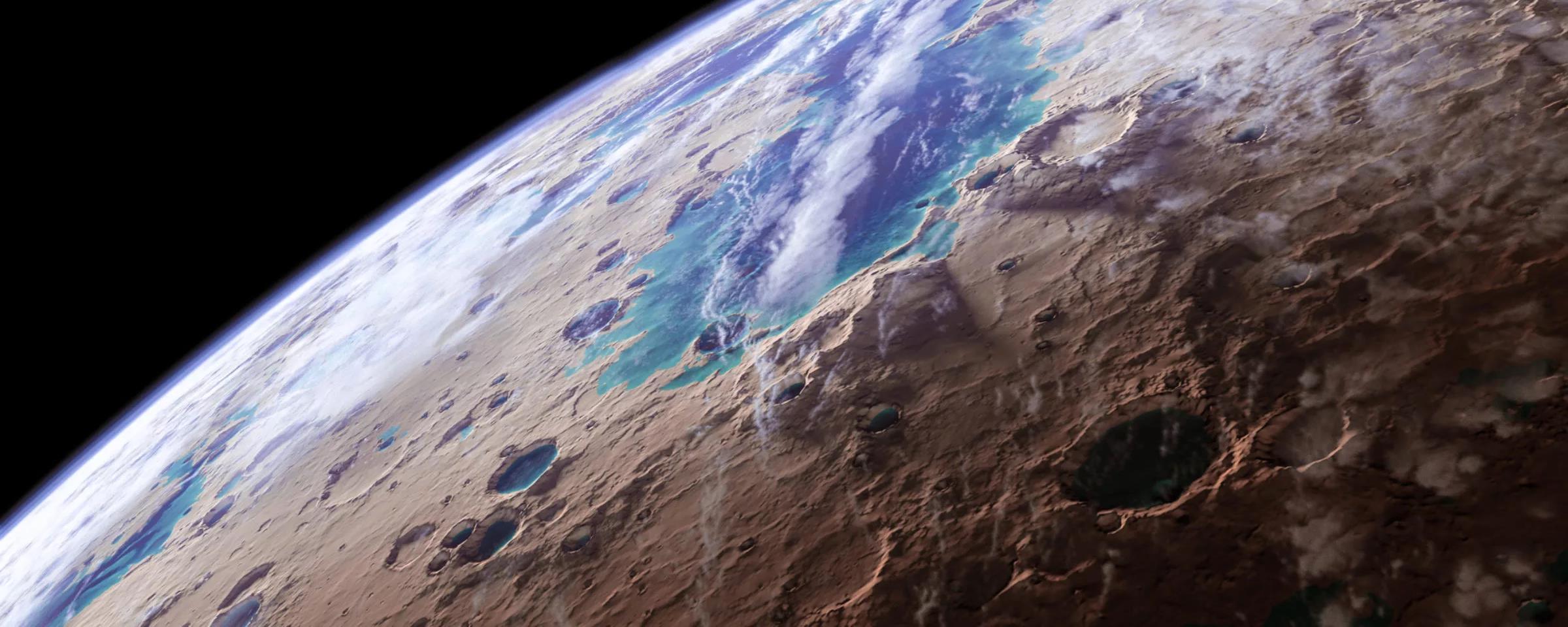
Type of buildings to which the project belongs, Architectural Trend, Study of contexts,
Critical issues, Study and analyze similar projects
At this stage, the organizational structures will be clarified and defined
Classification of major, supporting and minor elements and presentation of episodic analysis
Needs and performance requirements and display the operating periods and paths and episodic relationships
Finally, show the survey program
74
Research
It is the main objective of the project, which is to conduct research on the nature of the place, the weather and its surroundings
A secondary goal of the project is to set up experiments to help understand the materials on Mars to find better alternatives


The recreational area is considered a third goal, and it is in order to collect revenues for the colony and to create a new experience for tourists
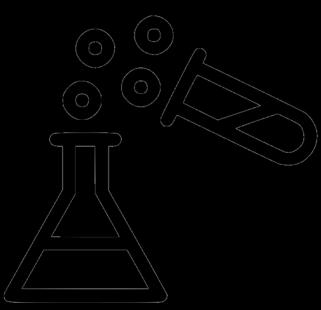
Experimental
75
Recreational
4.1








Administration Clinic STOREROOM Agriculture WORKSHOP LABORATORY Information & Resources Center Residency 77
Staff & TOURIST COMPONENTS RELATIONS
Administration
Educational & RESEARCH Entrance Security Foyer Labs
Entrance
Foyer Office W/C MEETING ROOM BREAK Exit MANEGAR W/C
Security
W/C Food & beverages Exit Common area 78
Staff & TOURIST COMPONENTS RELATIONS
Staff & TOURIST Residency
Privet Entrance Reception Dorm rooms & guest rooms Recreation W/C Exit
& Resources Center Food & beverages Entrance Security Foyer Water Filtration W/C Food & beverages Exit Common area Experiments + Studying + Supplies W/C 79
Information
4.2
The Research Level
The Experimental Level
81
Public Semiprivate
private
Administration
Educational & RESEARCH
Oxygen Generator “MAXEN”
Public Facilities
Communal Space
recreation center
Information & Resources Center
Agriculture
Energy Storage Facilities
Staff & TOURIST Residency
Labs ,Water Filtration ,Experiments
82
Loud quiet Moderate
Information
Center STOREAGE Maintenance Materials engineers MVP garage Publicity & Public Relation Agriculture MEETING
Library 83
Administration
& Resources
STOREROOM Staff & TOURIST Residency
4.3


Administration Information & Resources Center Residency Agriculture WORKSHOP LABORATORY STOREROOM ENTRANCE 85

Administration Administration & Personnel Director office Offices Administrative Assistants office Secretarial Support office Publicity & Public Relation Public Relations Officer office Offices Security Security officer office Offices Maintenance Offices Maintenance Engineers office supervisors office Technicians’ Station Janitorial office 86

WORKSHOP MVP garage Airlocks Offices Pressurized vehicle dock MEETING MEETING ROOMS Offices Security Security officer office Offices STOREAGE Serves Room General Store Collection Storage 87
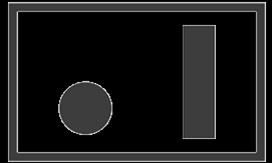
manager Quality Control Offices Materials engineers Technicians Assist Technicians Geologists/ geotechnical Technicians Geochemistry Assist Technicians 88
LABORATORY Technical

Agriculture Agriculture
Store For Vegetables Store For Equipment and hive servise Water Water basin Vaporize water back honey Bumblebee hive Honybee hive Pollination Of Bush Flowers 89
COLD
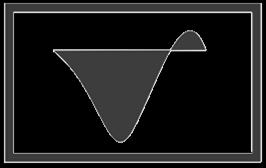
Information & Resources Center Library Reading Audio & visual room Storage Archives Offices Information Center Information Desk Information Offices Storage 90


Residency Habitat storeroom gym W/C laundry Rest area mesa kitchen STOREROOM Oxygen Generator “MAXEN” Storage Energy Storage Facilities Storage 91
05.
Type of buildings to which the project belongs, Architectural Trend, Study of contexts, Critical issues, Study and analyze similar projects

93
94
95
96
97
98







99
Type of buildings to which the project belongs, Architectural Trend, Study of contexts, Critical issues, Study and analyze similar projects

06.
01.
Gravity Acceleration
The gravitational acceleration on Mars is about 3.7 m/s2 , about one third of the Earth's gravitational acceleration. This makes all the "weights" and downward actions that the structures have to withstand much smaller on Mars than on Earth. To give an example, in Europe a floor of a residential building is checked to support a weight in use of 200kg/m2 while on Mars that same weight is 57kg/m2.

102
Wind


it would be expected that this was a very conditioning element in the design of the structure. However, analyzing the wind speed records on Mars we come across values far below the expected. The maximum wind speed ever detected on Mars was about 30 m/s, much lower than the maximum speed detected on Earth. In order to be able to compare the wind of the planet Mars with the wind of the Earth, an interpolation was performed that first compares maximum wind speeds in sandstorms and then calculates the base wind speed.

103
Earthquakes
in order to be perceptible to the human. As the ground accelerations caused by these kinds of forces are of Armstrong's order of magnitude, the response times of the structures and the impact on them are negligible. As we can notice in the data collected by the probe (Banerdt 2020), for the same distance from the epicenter, there are vertical accelerations, oscillations and magnitudes drastically smaller than those of the Earth.

104
Meteorites
As the mass of Mars is much smaller than that of Earth, the gravitational acceleration of the red planet is significantly smaller than that of the Earth.

The weak gravitational pull results in an atmosphere on Mars significantly less dense than that of the Earth and a magnetic field with less repulsive power than the Earth.
The probability of being hit by a meteorite is quite low, but still much higher than on Earth.
105
Radiation
The lack of protection caused by a thin atmosphere and a weak magnetic field exposes, without any kind of protection, the crew members of the colonization mission to solar and cosmic radiation. For example, on the International Space Station, due to the station's proximity to Earth, the problem is mitigated by the Earth's strong magnetic field.
Data collected from NASA - Space Radiation database.
Average exposure to radiation per year on Earth: 3 mSv
Average radiation exposure per year on Mars: 600 mSv
Maximum permissible exposure of one astronaut per year: 50 mSv
According to the data obtained, a protection factor of 92% is necessary in order to create structures and life bases capable of providing radiation safety.

106
Pressure
The atmospheric pressure on Mars is 610 Pa, which represents 0.6% of the Earth's atmospheric pressure.

Considering that the pressure inside the habitat will have to be the Earth's atmospheric pressure or close to it, there will always be a pressure difference that will perform the balloon effect on the structure. Thus, the structure material will need to be resistant to this pressure. The value of this pressure is 10,070 kg/m2

107
DUAL SHELL
employ a unique dual-shell scheme to isolate the habitable spaces from the structural stresses brought on by Mars’s extreme temperature swings. This separation makes the interior environment unbeholden to the conservativism required of the outer shell, which retains its simple and effective form.
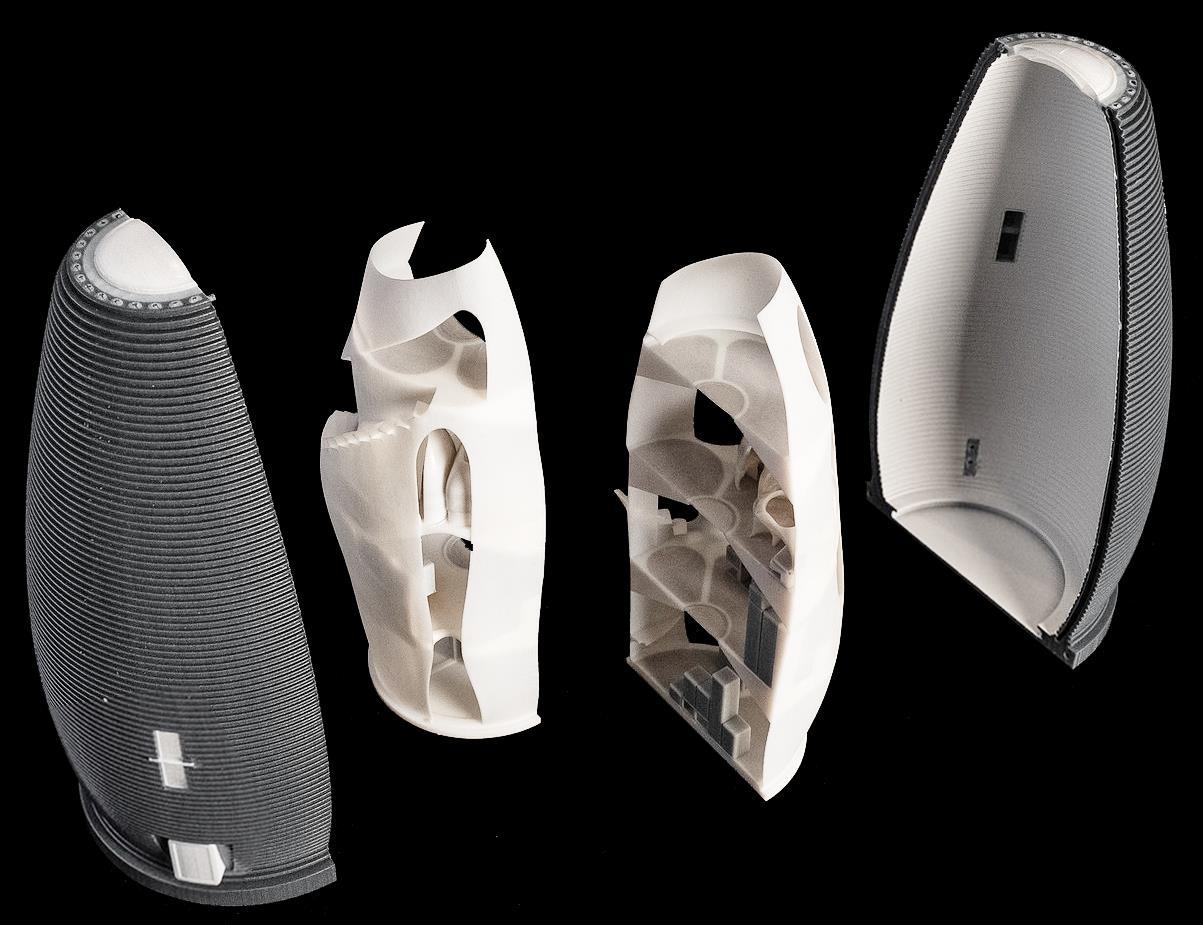
108
IMPROVED STRUCTURE
half-buried structure, but a bright, multi-level, corridor-free home that stands upright on the surface of Mars. Where structures on Earth are designed primarily for gravity and wind, Martian conditions require a structure optimized to handle internal atmospheric pressure and thermal stresses. Marsha's unique vertically oriented, egg-like shape maintains a small footprint, minimizing mechanical stresses at the base and top which increase with diameter. Standing tall on the surface grants the human crew a superior vantage point to observe a dynamic landscape with weather patterns, clouds, and shifting hues – their new home and object of study. The tall, narrow structure reduces the need for a construction machine to continuously rove on the surface, reducing risk and increasing speed and accuracy.
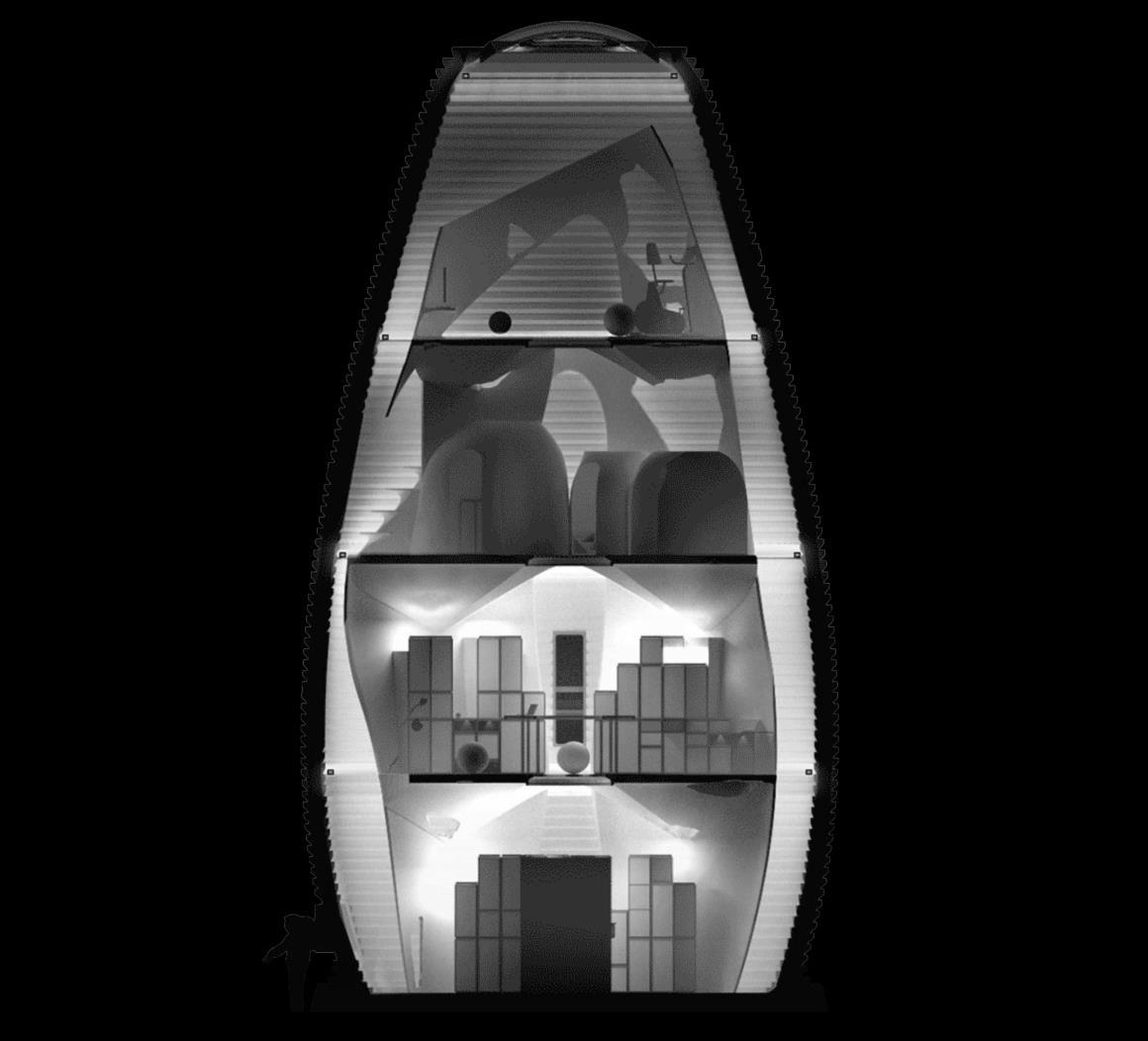
109
Handling Radiation


Three basic methods for reducing radiation exposure exist; increasing the distance to the radiation source, reducing the amount of time exposed to radiation, or shielding from the radiation source with a material capable of absorbing radiation (American Nuclear Society, 2014). The former and the latter of these methods focus on reducing the intensity of the radiation, however shielding seems to be the only method that can be used in the design of manned Mars missions. The amount of time exposed to radiation is determined by the length of the mission. The current length of a manned mission to Mars is estimated to last three years, but possible future rocket technology could bring this time down and bring exposure time down with it .
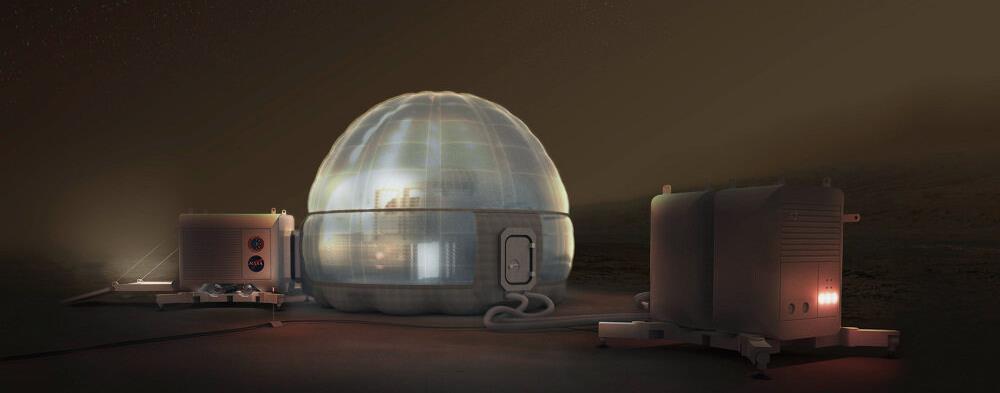
110
Living Underground
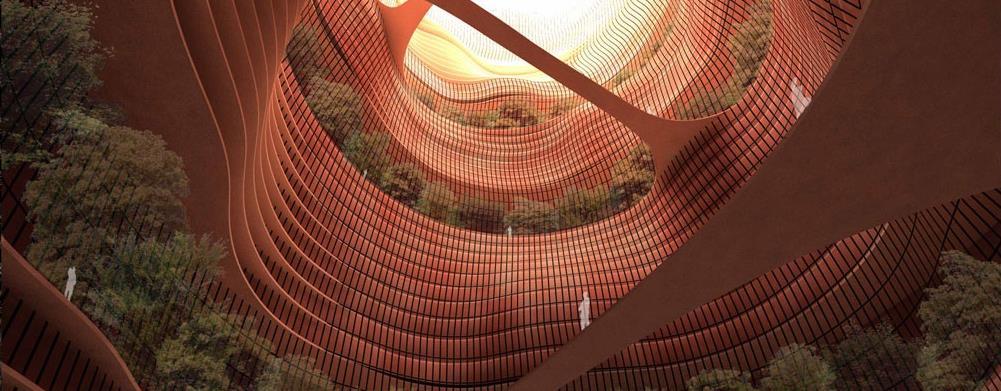

Mars itself provides the materials necessary for radiation shielding. In the past humans have made underground shelters to protect themselves from nuclear fallout. Many of the same solutions can be applied to habitats on Mars. Lava tubes cover the planet where lava had previously dug through the surface. They now leave caves with ceilings that can block out radiation.Inside lava tubes, humans will not have to worry about the high levels of radiation. This would allow for the habitats to be inflatable, thus making them dramatically lighter. For a large-scale colony, this would allow for a multitude of inflatable habitats to be transported from Earth instead of one that requires added radiation shielding.
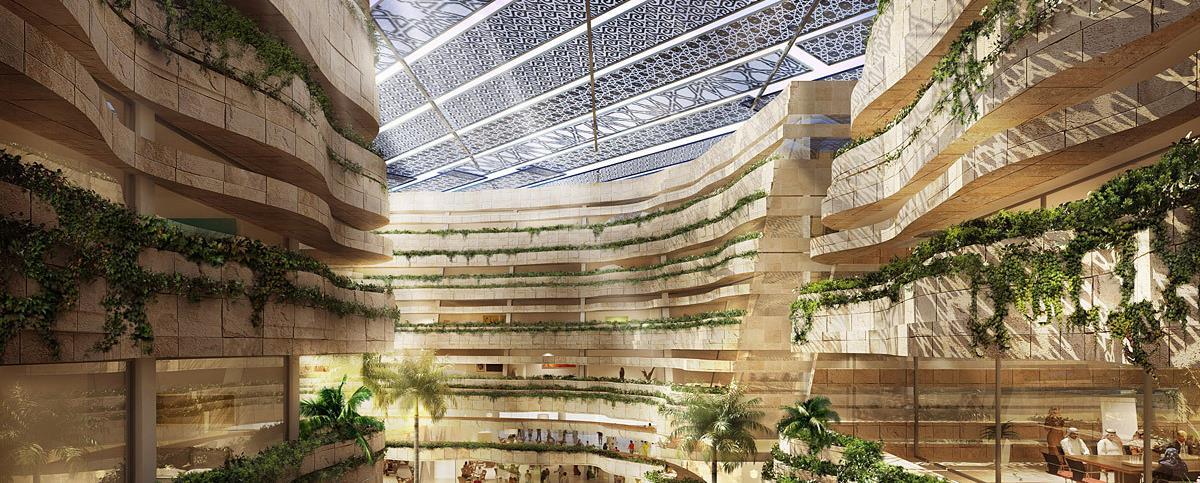
111
02.
REST AREA WORK AREA ENTRANCE AREA
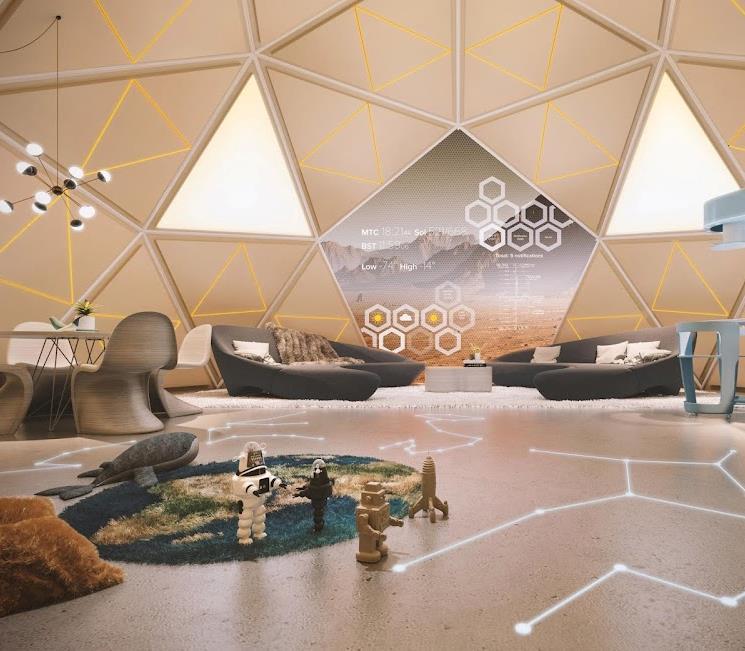


113
The Airlock

Every crew exiting the Hab for an Extra Vehicular Activity (EVA) must spend time to simulate decompression in the airlock. This is because the average pressure on Mars equals that we can find at 35 km above Earth: 0.6% from the pressure we know here on Earth. The effects of low pressure on the human body are starting only now to be studied and understood.

114
Avoid Perchlorates at all cost. Mars dust is toxic and will do significant damage to the thyroid glands. Items will be handled with care in this Inlet Laboratory.


115
two-shell structure creates flexible, hybrid spaces which offer a variety of lighting conditions, privacy, noise levels and uses

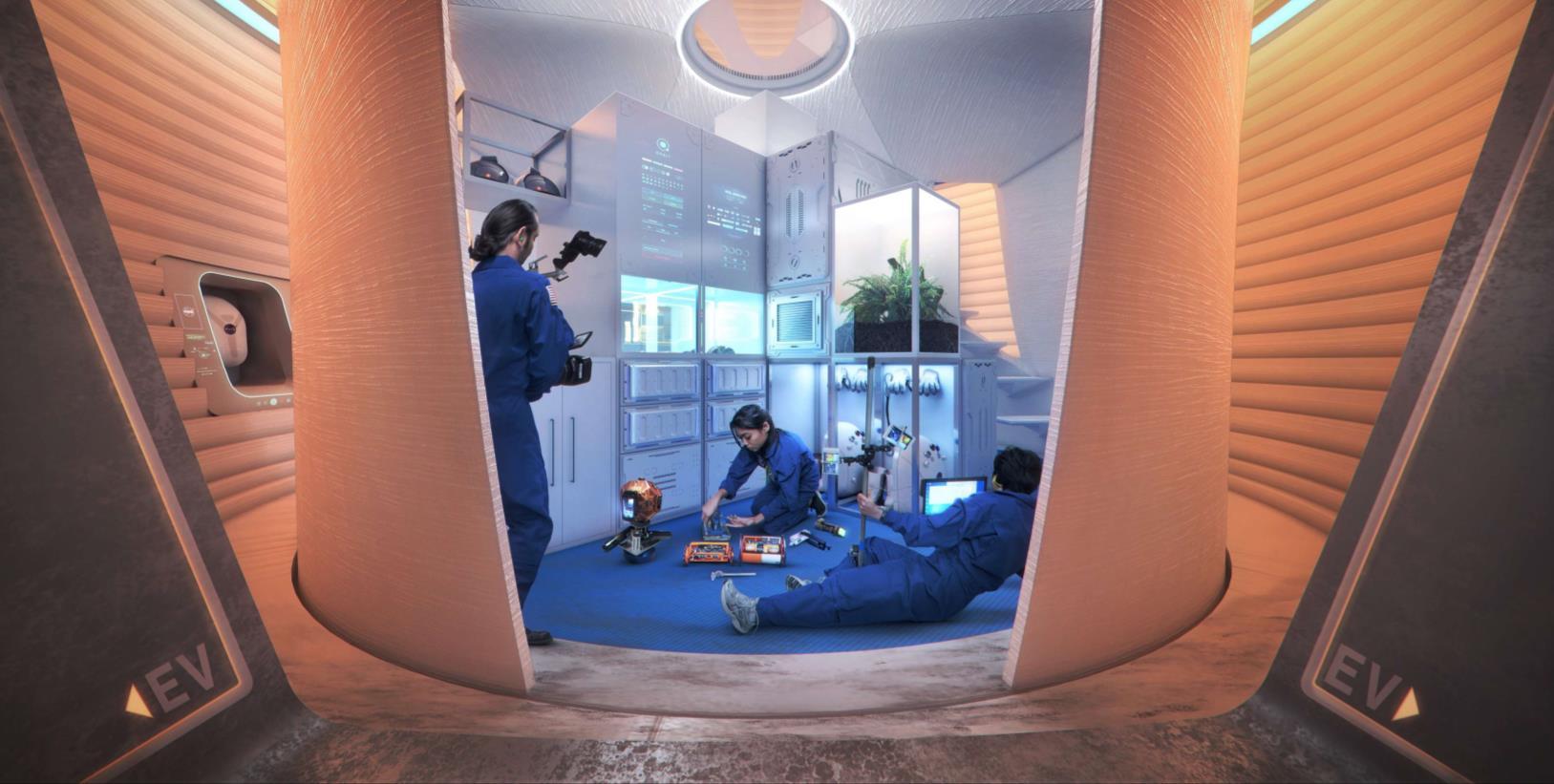
. 116
All the rooms/interior spaces of Martian habitat need to be arranged in the best possible way to get mutual benefits from each other and minimize the circulation areas as much as possible. For example, instead of designing a separate greenhouse for less sensitive plant, the plants can be grown in the common areas, or even inside the living quarters of the crews. It will create a lively interior environment with visual comfort for the crews in a red planet. Another important consideration for this internal arrangement will be to ensure clear distinction between public and private spaces or at least a visual illusion of it so that the crews can get enough privacy for their psychological wellbeing.

117
This is the most efficient way to minimize the total area of a habitat as well as to minimize the cost. This multifunctional space needs to be designed with a quality to serve properly most of the common functional areas, like- dining, leisure and festivals, exercise, work, library, nonspecialized lab and collected sample storage, central communication and so on. In addition, this common space can serve as an emergency backup shelter, if anything happen in the outer protection barrier. For this reason, it has to be designed as a self-sufficient living unit with all necessary life support.
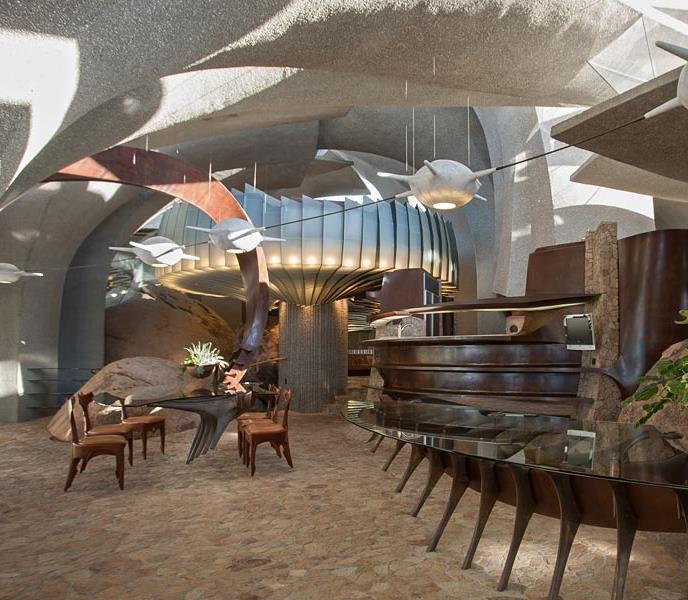
118
The successful design of illusions using the reactions of human senses will determine the success level of healthy psychological environment as well as better performance. Some important considerations for designing these illusions are - a small space with large appearance, a false window with a real video clip from a crew‟s home window of Earth, programmed lighting system to create randomly changing weather effect, a pre-programmed sound system with hidden speakers to generate random sounds of Earth‟s nature and so on. These unexpected randomness and carefully designed illusions will influence a crew‟s subconscious mind and thus will be a relief in his/her hard monotonous life on Mars.

119
Type of buildings to which the project belongs, Architectural Trend, Study of contexts, Critical issues, Study and analyze similar projects

07.
In the fifth stage, all previous stages will be summarized
The first stage: the stage of introducing the project
The second stage: the stage of analyzing the location and influencing contexts
The third stage: critical issues
The fourth stage: the project programme
Recommendations, directions and design approaches will be mentioned
121
This map shows the top of Jezero Crater’s delta. The rover’s planned route is in black, with black dots representing notional waypoints for science or sampling along the way, while the ground it already covered is in white.


122
Map of Eberswalde: A Delta Within a Delta


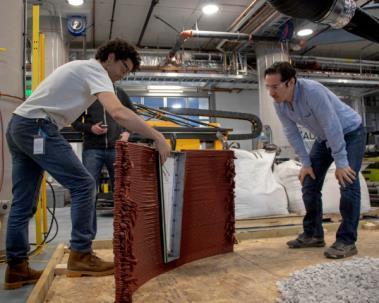



123

124
CRITICAL ISSUES
ThinAtmosphere
One of the most important attributes a planet needs to support human life is an atmosphere. Unfortunately, a very thin one clings to Mars . Is mostly composed of carbon dioxide (95.3% compared to less than 1% on Earth). Has barely any oxygen (0.13% compared to 21% on Earth), which humans need to breathe. Contains very little nitrogen (2.7% compared to 78% on Earth), which plants need to survive.
HighLevelsofRadiation
Harmful radiation permeates the cosmos. Our sun and other stars are essentially fusion reactors that spew abundant amounts of electromagnetic energy, including X-ray and ultraviolet radiation. The sun, as well as other intensively energetic objects like quasars or the center of galaxies, also emit high-energy protons, atomic nuclei and other particles that can cause radiation sickness, adversely affect a person’s central nervous system, increase one’s lifetime risk for cancer and cause degenerative diseases.
DustStorm
Every year there are some moderately big dust storms that pop up on Mars and they cover continent-sized areas and last for weeks at a time, Beyond Mars’ large annual storms are massive storms that occur more rarely but are much larger and more intense.
“


Once every three Mars years (about 5 ½ Earth years), on average, normal storms grow into planetencircling dust storms, and we usually call those
‘global dust storms’ to distinguish them,” Smith said.

125





126



127


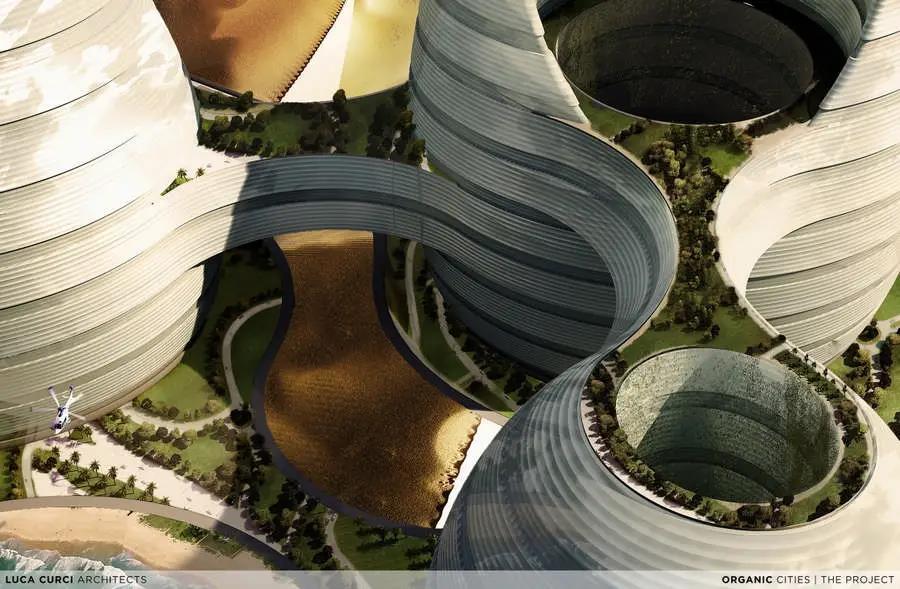
128
129
130
131
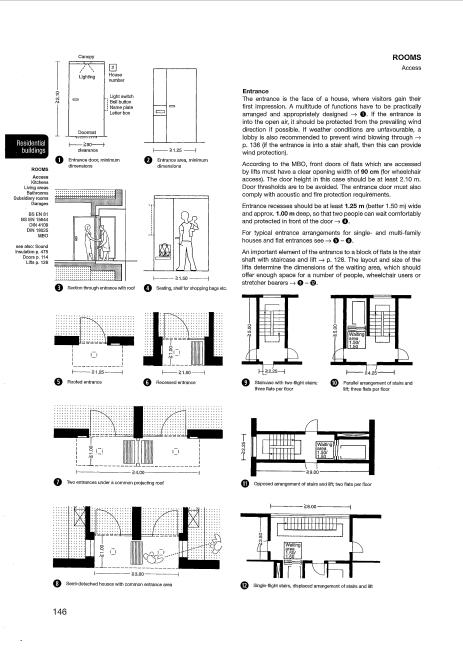




132
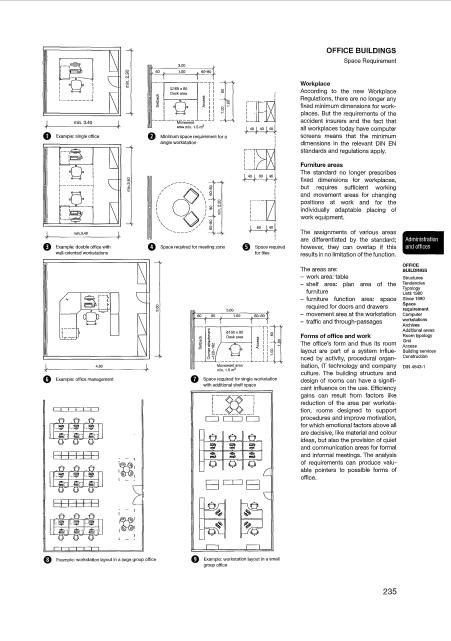


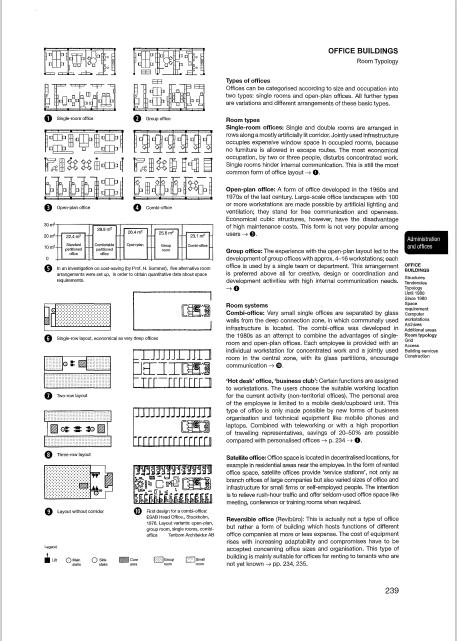

133
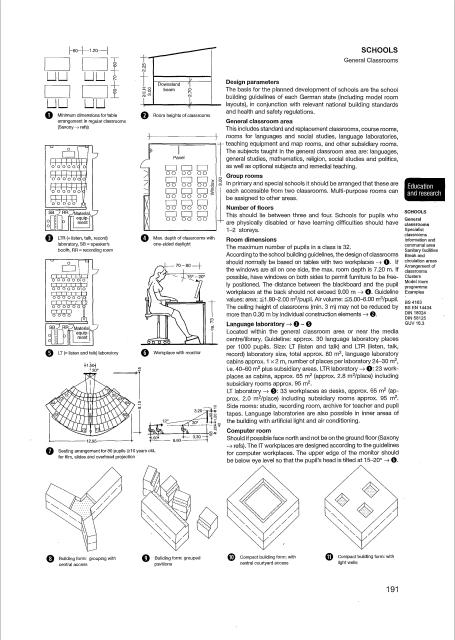



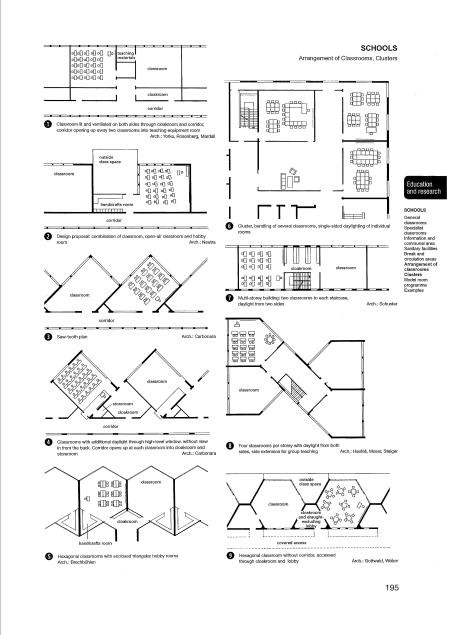
134


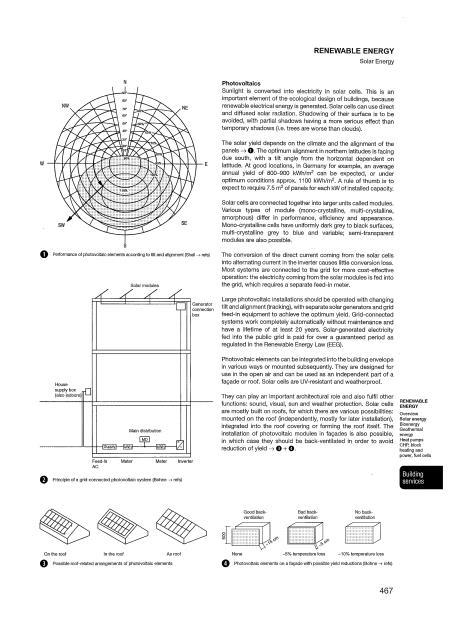


135



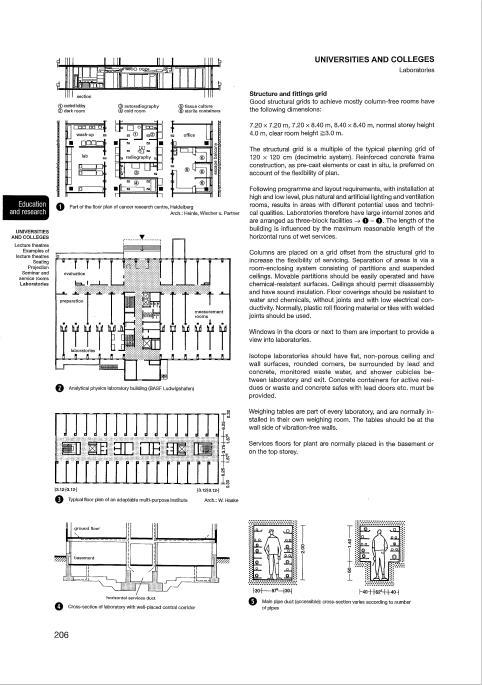
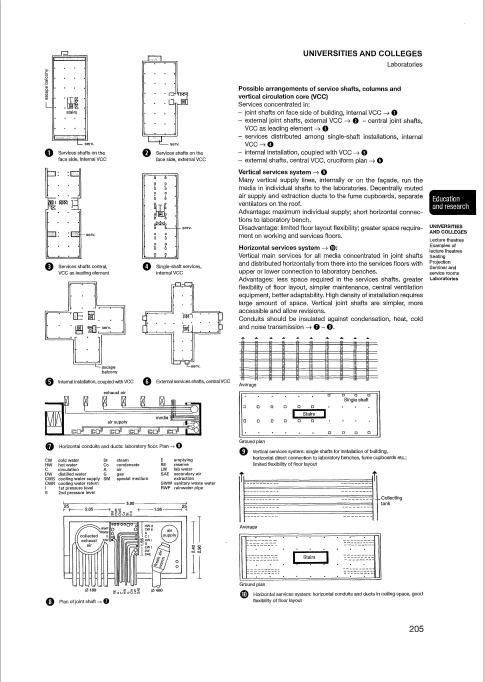
136
For all of Humanity’s existence, it has only known Earth as a home. Adopting Mars as a secondary planet provides many challenges that threaten the lives of those people willing to live there. However, though there are many dangers there are many ways that they can be overcome. For a long-term colony on Mars, using architecture to incorporate solutions to these problems into the design of the habitat is the best way forward. The habitat should look to solve extreme radiation by using pile regolith and 3D printed structures. This provides an effective source of protection, but is also simplistic in the work needed to protect a shelter. Lava-tubes would eventually provide a great alternative, but are unrealistic in their manufacturing requirement for initial societies. Though the cold temperatures are extreme on Mars, the inability to efficiently transfer heat through its low-density atmosphere allows for the use of normally insulation techniques. Without adequate air, water, and food, the colony will not make it far. Using instruments such as MOXIE, to clean and produce air will ensure that the society can survive on its own. Plants should also be used not only as an addition to the water and air purification, but also as a key resource for the colony’s food supply. Once humans can be taken care of physically, the architecture of the habitat must work to retain their mental stability. Social “spaces” must be created so the norms of society do not change from Earth, this will ensure both a strong community bond, but also the creation of a new home. Only until astronauts are able to make the habitat their own and begin to create memories inside it will it become a home to the people who inhabit it.
137
And with that ,we completed the Project work for the Saudi Space Commission in Course graduation project 1 Arch 434.And I would like to thank all those who contributed to making this work a reality and stood by my side until we achieved it together.
So I thank DR.AYMAN ALMUSHARAF for the love and generosity he gave us in this cours
138
